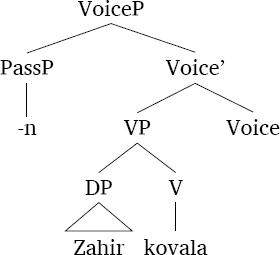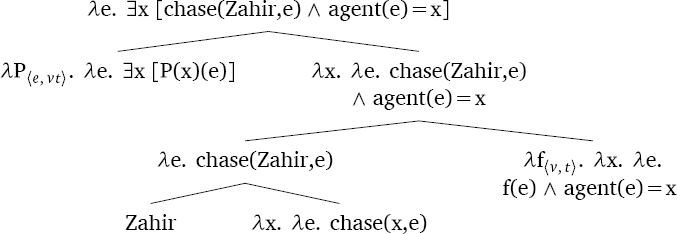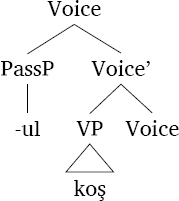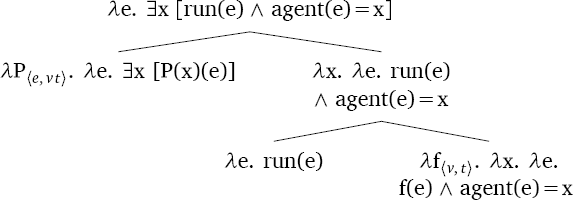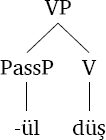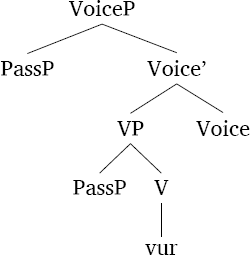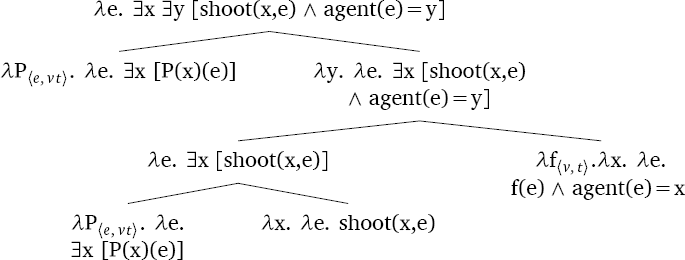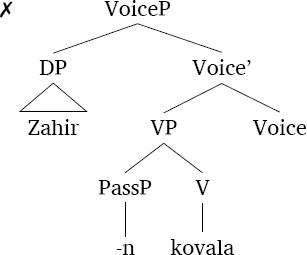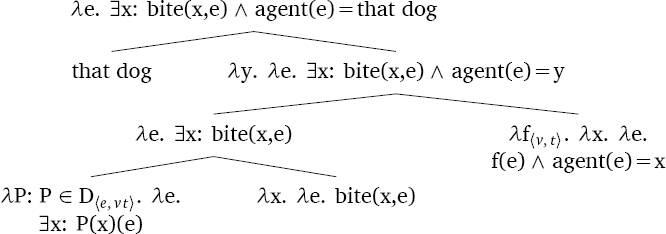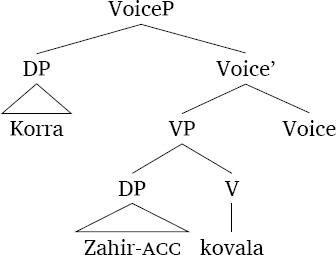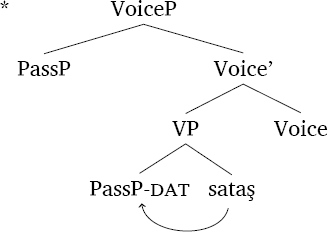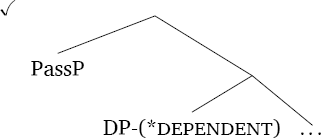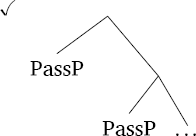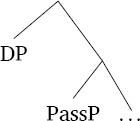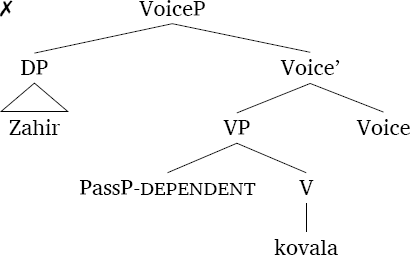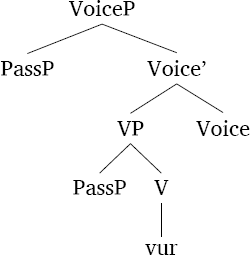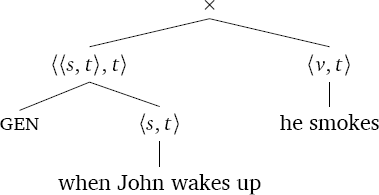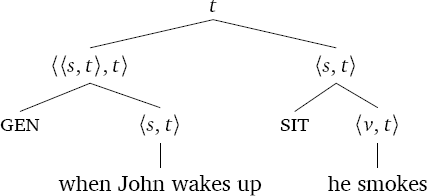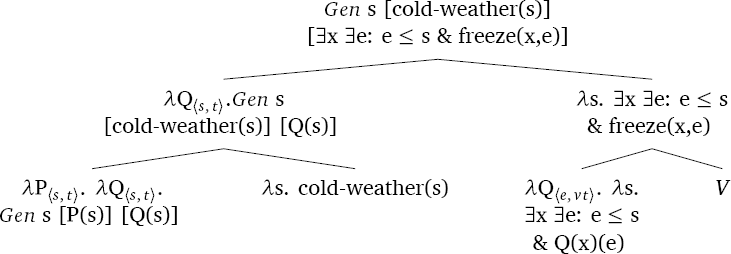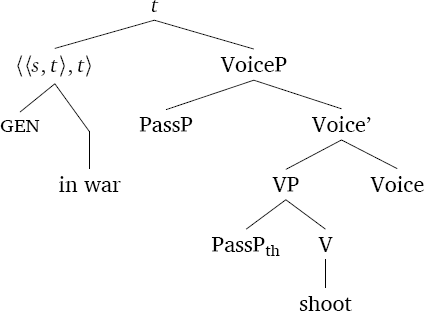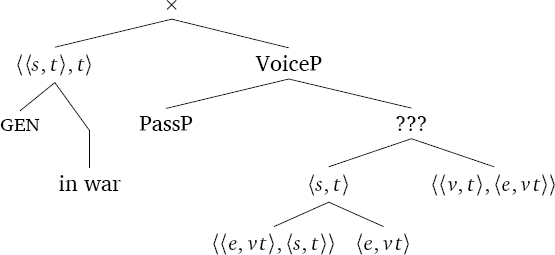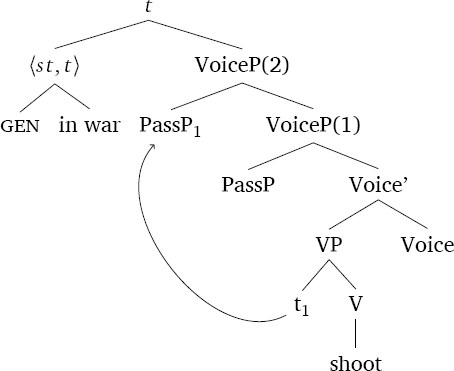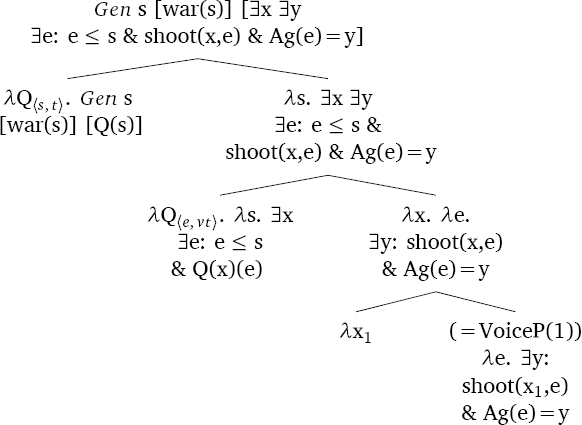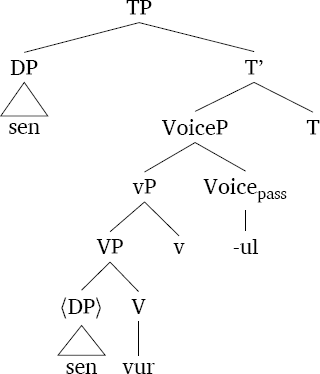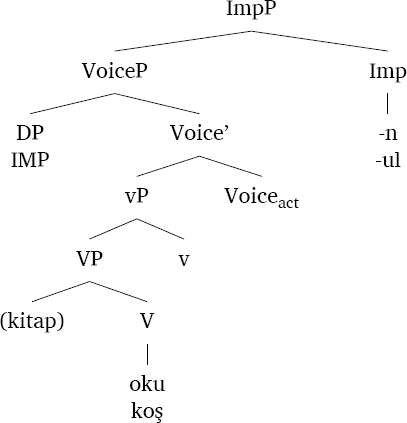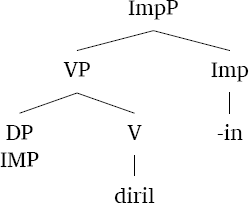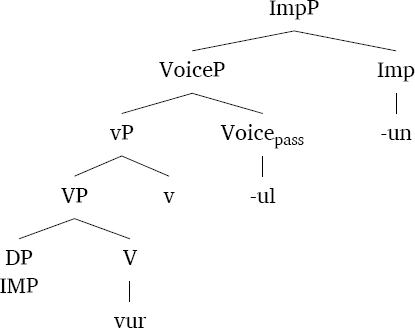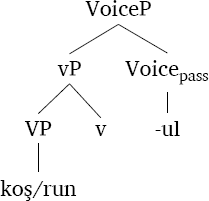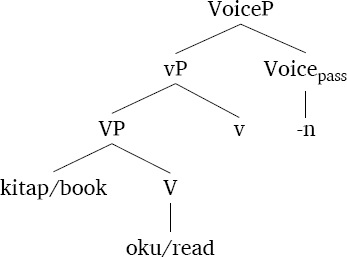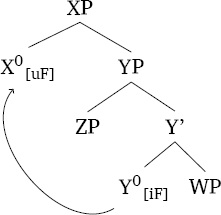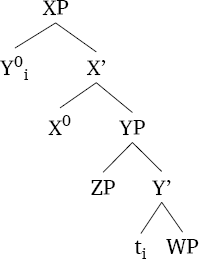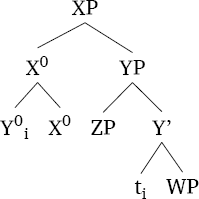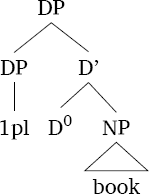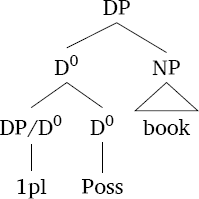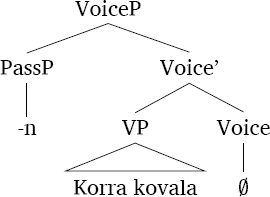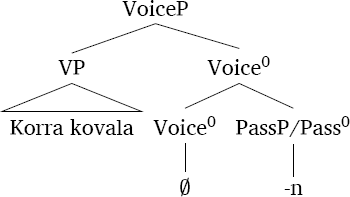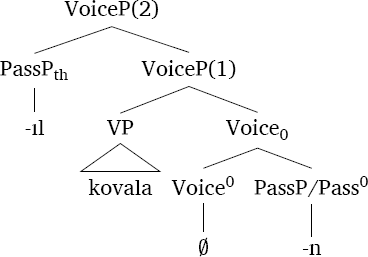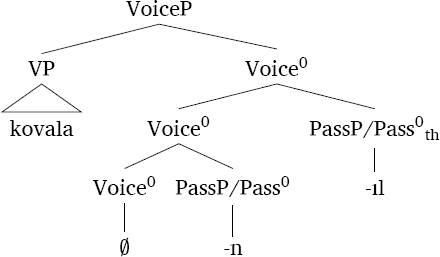1 Introduction
Turkish allows for canonical (English-type) passives where objects surface as grammatical subjects after the deletion of initial subjects (Özkaragöz 1980; Özkaragöz 1986; Biktimir 1986; Taneri 1993). (1a) is an active clause with a two-argument verb (henceforth transitives) whereas (1b) is its passive counterpart. (1c) shows that it is possible to specify the deleted subject as a PP adjunct.
- (1)
- a.
- Korra
- Korra
- Zahir-i
- Zahir-acc
- kovala-dı.
- chase-pst
- ‘Korra chased Zahir.’
- b.
- Zahir
- Zahir
- kovala-n-dı.
- chase-pass-pst
- ‘Zahir was chased.’
- c.
- Zahir
- Zahir
- Korra
- Korra
- tarafından
- by
- kovala-n-dı.
- chase-pass-pst
- ‘Zahir was chased by Korra.’
As shown in (2), passivization has morphosyntactic consequences for case and agreement realization: an underlying object DP surfaces as nominative and becomes the target for verbal agreement.
- (2)
- a.
- Korra
- Korra
- biz-i
- 1.pl-acc
- kovala-dı.
- chase-pst
- ‘Korra chased us.’
- b.
- Biz
- 1.pl.nom
- (Korra tarafından)
- Korra by
- kovala-n-dı-k.
- chase-pass-pst-1.pl
- ‘We were chased (by Korra).’
In addition to canonical passives, Turkish also allows for subject less passives, which, as the name suggests, lack surface subjects. Subject less passives are generated when the sole argument of a one-argument verb, henceforth intransitives, is deleted by passivization. They can be generated both from unergative and unaccusative predicates in Turkish.
- (3)
- a.
- Bu
- This
- çukur-a
- hole-dat
- düş-ül-ür.
- fall-pass-aor
- ‘One may fall to this hole.’
- Lit(eral): ‘It is fallen to this hole.’ (unaccusative)
- b.
- Dün
- yesterday
- maraton-da
- marathon-loc
- koş-ul-du.
- run-pass-pst
- ‘There was running in the marathon yesterday.’
- Lit: ‘It was run in the marathon yesterday.’ (unergative)
In addition, passivization may also target objects of transitives, but crucially only if their subjects are already suppressed by passivization. Such structures where both the object and the subject of a transitive predicate are suppressed by passivization are commonly referred to as double passives in the literature (see Özkaragöz 1986).1 (4a) is an instance of double passivization where the passive morpheme is iterated, and both the subject and the object are suppressed.2 (4b) shows that the object of a transitive verb cannot be suppressed using a passive morpheme when its subject is not suppressed. In other words, it is impossible to understand Zahir, the only overt argument in (4b), to be the agent, i.e. the chaser: Zahir in (4b) is necessarily the theme, i.e. the one that was chased.
- (4)
- a.
- Harp-te
- war-loc
- vur-ul-un-ur.
- shoot-pass-pass-aor
- ‘One is shot (by one) in war.’ (Özkaragöz 1986: 76)
- b.
- Zahir
- Zahir
- kovala-n-dı.
- chase-pass-pst
- i. ✖ ‘Zahir chased somebody.’
- ii. ✔ ‘Zahir was chased.’
Finally, we observe a commonality between double passives and passives of unaccusatives where the logical object is suppressed, and between canonical passives and passives of unergatives where there is only logical subject supppresion. We observe that canonical passives and passives of unergatives are compatible with episodic contexts (see (5a)–(5b)) whereas passives of unaccusatives and double passives only tolerate generic statements when passivized (compare (6a) and (6b) with (3a) and (4a) respectively).
- (5)
- a.
- Bu
- This
- kitap
- book
- dün
- yesterday
- oku-n-du.
- read-pass-pst
- ‘This book was read yesterday.’ (canonical passive)
- b.
- Dün
- yesterday
- konser-de
- concert-loc
- bağır-ıl-dı.
- shout-pass-pst
- ‘Someone/People shouted in the concert yesterday.’
- Lit: ‘It was shouted in the concert yesterday.’ (passive of unergative)
- (6)
- a.
- *Ay,
- Oh,
- az
- short
- once
- before
- çukur-a
- hole-dat
- düş-ül-dü.
- fall-pass-pst
- Int(ended): ‘Oh, people/someone fell to this hole a short time ago.’
- Lit: ‘It was fallen to this hole a short time ago.’ (passive of unaccusative)
- b.
- *Birinci
- first
- dünya
- world
- savaş-ın-da
- war-poss-loc
- vur-ul-un-du.
- shoot-pass-pass-pst
- Int: ‘One/Someone was shot (by someone) in WWI.’ (double passive)
Here are our puzzles: How is it that a language that allows for the suppression of subjects in (in)transitives and of objects in double passives does not allow suppressing exclusively the object of a transitive verb? There is no a priori reason for why passivization in Turkish must first target subjects in order to target objects, particularly considering the fact that Turkish allows for passives of those intransitives whose sole arguments are object-like (hence the class of intransitives generally referred to as unaccusatives (Perlmutter 1978)). Second, what prohibits the formation of double passives and passives of unaccusatives in episodic contexts?
In the rest of this paper, we are going to refer to the structure that would give rise to the unavailable interpretation in (4b)-i as the antipassive configuration. Given that antipassives are not cross-linguistically barred (Silverstein 1972; Kalmár 1977; Postal 1977; Cooreman 1994; Campbell 2000; Aldridge 2012; Polinsky 2017 among others), it is a legitimate question why Turkish lacks them despite the fact that it has double passives. Hence, this paper aims to account for how the antipassive configuration illustrated in (4b)-i is ruled out in the grammar of Turkish, as well as addressing the issue of how double passives are generated. Since the puzzle presented here is crucially based on the fact that intransitives are passivizable, we will also provide evidence in favor of the fact that passives involving intransitives are, in general terms, semantically generated by the same operation involved in passives of transitives (i.e., the existential closure of argument slots) contra Legate et al. (2020), who argue that impersonal passives are actually active impersonal constructions that happen to be marked the same as canonical passives. In addition, we will also provide an analysis of aspectual properties of passives of unaccusatives and double passives as opposed to passives of unergatives and canonical passives.
Our paper is structured as follows. In Section 2, we provide our analysis of double passive clauses in Turkish. In Section 3, we propose a dependent case-theoretic reasoning for why antipassives are ruled out in Turkish. In Section 4, we propose to account for certain aspectual restrictions of passives of unaccusatives and double passives, which has received very little attention in the literature. Section 5 compares our proposal to the existing proposals, in particular the proposal in Legate et al. (2020). Section 6 concludes this paper.
2 Deriving double passives in Turkish
This section discusses how double passives are generated in Turkish. We first provide the structure that we adopt for canonical passives. Then, we extend our analysis to passives of intransitives and double passives. In the next section, we turn to our main puzzle and argue that the absence of antipassives is best explained in case-theoretic terms, in particular under the assumptions of Dependent Case Theory (Baker & Vinokurova 2010).
2.1 Canonical passives
Passivization is generally taken to apply to predicates with external/agentive arguments such as three-argument verbs, henceforth ditransitives, transitives or the class of verbs generally referred to as unergatives (Perlmutter 1978; Sternefeld 1995; Kratzer 1996; Collins 2005; Pylkkänen 2008; Bruening 2013; Müller 2016). The idea was first formalized in generative theories with Kratzer (1996)’s Voice, which has then been argued to be only available in clauses that host agentive arguments (Alexiadou et al. 2006; Schäfer 2012; Alexiadou 2014; Harley 2017 among others). Although proposals vary in their technical implementation, it has been commonly accepted that passivization involves existential quantification over an argument position. We also adopt this basic idea for all kinds of passivization in Turkish. However, unlike the general tendency, we do not take passive morphemes to be functional elements (e.g. as a “flavour” of Kratzer’s Voiceact), but as items that are ontologically on a par with DPs and CPs that occupy thematic positions themselves following Jaeggli (1986); Baker et al. (1989) and Taneri (1993).3 The basic intuition behind this idea is that passivization targets thematic positions that would otherwise be occupied by DPs or CPs. This assumption will allow us to state our theory of how antipassives are ruled out in the grammar of Turkish.
We follow Kratzer (1996), a.o., in severing the external argument from the verb while keeping the internal argument as an argument of the verb. Under these assumptions, a canonical transitive clause such as (7a) will be represented as in (7b). (8) is a sample semantic derivation for (7).
- (7)
- a.
- Korra
- Korra
- Zahir-i
- Zahir-acc
- kovala-dı.
- chase-pst
- ‘Korra chased Zahir.’
- b.
- (8)
According to (8), the transitive verb kovala ‘chase’ takes its object VP-internally and returns a predicate of events. Then, Voice takes this predicate as its argument and associates the event with Zahir, its agent. What passive does is to existentially bind the relevant argument positions. Hence, a canonical passive is going to bind the argument position introduced by Voice (see (10) and (11)). Accordingly, the denotation that we adopt for the passive morpheme in Turkish is given in (9).
- (9)
- ⟦passp⟧ = λP: P ∈ D⟨e,vt⟩. λe. ∃x: P(x)(e)
- (10)
- a.
- Zahir
- Zahir
- kovala-n-dı.
- chase-pass-pst
- ‘Zahir was chased.’
- b.
- (11)
Since we assume that the passive morpheme is itself a thematic entity, we argue that it is merged in [Spec, Voice] on a par with DPs as illustrated in (10) and (11). Our proposal that the passive morpheme is argumental predicts that it can not only occur in [Spec, Voice], but also as a sister to V, hence the passives of unaccusatives. In the next sub-section, we discuss passives of intransitives in general.
2.2 Passives of intransitives
We have shown that Turkish allows for passives of intransitives. Turkish may passivize so-called unergative predicates, which is expected, for their sole arguments are agentive, and therefore syntactically on a par with transitives with the exception that unergatives do not have VP internal arguments.
- (12)
- a.
- Dün
- yesterday
- maraton-da
- marathon-loc
- koş-ul-du.
- run-pass-pst
- ‘There was running in the marathon yesterday.’
- b.
- (13)
Unlike many other languages and in violation of Perlmutter (1978)’s generalization, Turkish also allows for passives of unaccusatives. However, our analysis predicts the availability of passives of unaccusatives in Turkish, for we propose that the passive morpheme is argumental; that is, it must occur in an argument position. Since the sole argument of an unaccusative verb is VP-internal (Perlmutter 1978), the passive morpheme may directly combine with a verb, creating a passive clause with an unaccusative predicate.4
- (14)
- a.
- Bu
- This
- çukur-a
- hole-dat
- düş-ül-ür.
- fall-pass-aor
- ‘One may fall to this hole.’
- Lit: ‘It is fallen to this hole.’
- b.
- (15)
2.3 Double passives
We have thus posited that the passive morpheme is argumental, and therefore occupies thematic positions. Hence, our analysis predicts not only passives of transitives and unergatives, but also passives of unaccusatives. This is an accurate formalization of facts: if a language may generate passive clauses involving unaccusatives, then PassPs in that language should be able to merge under VP, for arguments of unaccusative predicates are complements to verbs. If passivization in a language targets agentive or external arguments, then PassPs in that language should also be able to merge in the external argument position, which we assumed to be [Spec, Voice]. Considering that the passive morpheme is argumental, it may be found in both the object position and the subject position, generating double passives as in (16).
- (16)
- a.
- Harp-te
- war-loc
- vur-ul-un-ur.
- shoot-pass-pass-aor
- ‘One is shot (by one) in war.’ (Özkaragöz 1986)
- b.
- c.
The structure in (16b) represents double passives and is theoretically desirable because both PassPs locally saturate argument positions, as shown in (16c). However, it has an obvious shortcoming. Everything else being equal, it overgenerates, allowing for antipassives, which we previously showed to be unavailable in the language (see (4b)-i repeated as (17)). (16) shows that double passives are generated when both argument positions are locally saturated by a PassP. However, the system we have been arguing for thus far is also able to merge a PassP in the object position along with a higher DP in [Spec, Voice]. This generates an antipassive configuration, certainly unattested in Turkish. And so far, we have not introduced any semantic or syntactic constraint to block this configuration.
- (17)
- Zahir
- Zahir
- kovala-n-dı.
- chase-pass-past
- i. ✖ ‘Zahir chased somebody.’
- ii. ✔ ‘Zahir was chased.’
- (18)
- (19)
It is apparent that the availability of (16b) incorrectly rules in the structure in (18). However, we still argue that (16b) is the right structure of double passive constructions. We propose that there is nothing in the semantics that rules out antipassives. Rather, (18) is ruled out in case-theoretic terms under the assumptions of dependent case theory (Marantz 1991; Baker & Vinokurova 2010; Levin & Preminger 2015), which we will discuss in Section 3.
3 Ruling out antipassives
3.1 Background on antipassives
The term antipassive, first coined by Silverstein (1972; 1976), may refer to a variety of constructions. Its use in the literature can be seen to subsume (pseudo) noun incorporation, conative and even implicit object constructions (Polinsky 2017; Heaton 2017) For example, Baker (1988) takes antipassive constructions to be a special type of a noun incorporation. However, its most broad and accepted definition is the one where a transitive predicate is added a detransitivizing morpheme which, on the surface, demotes the logical object of a transitive predicate either to an oblique or deletes it completely (see Dixon 1994). Hence, while passivization takes a transitive predicate and intransitivizes it by suppressing its logical subject, antipassivization makes a transitive predicate intransitive by suppressing its logical object. Although Turkish does exhibit (pseudo) noun incorporation and implicit object constructions, the goal of this paper is not to explain why they are available in the language or whether these can be subsumed under antipassives or not. Rather, we are interested in the peculiar behaviour of the passive morpheme in Turkish which can be iterated to saturate internal and external argument positions but cannot occur in the configuration illustrated in (18). This configuration corresponds to the definition of antipassives where the logical object seems to be deleted on the surface, replaced by a detransitivizing morpheme. This configuaration is certainly not crosslinguistically barred. For example, Fleck (2006) shows that it is possible to delete the object of a transitive clause independently of its subject in Matses.
- (20)
- a.
- aid
- that.one
- opa-n
- dog-erg
- matses-Ø
- people-abs
- pe-e-k.
- bite-npst-indicative
- ‘That dog bites people.’
- b.
- aid
- that.one
- opa-Ø
- dog-abs
- pe-an-e-k.
- bite-ap-npast-indicative
- ‘That dog bites (me/us …).’ (Fleck 2006: 559)
Matses is an ergative-absolutive language where the object of a transitive clause has the absolutive case whereas the subject is marked with the ergative case. As expected in an ergative language, the sole argument of an intransitive predicate has absolutive case. In Matses, absolutive case is unmarked while the suffix -n is the exponent of ergative case. As observed in (20a), the predicate is transitive with two arguments. The object argument has absolutive while the subject is marked with ergative as expected. However, once the predicate is suffixed with the antipassive morpheme -an in (20b), the object argument is suppressed, and left with an indefinite meaning similar to the implicit arguments of impersonal passives, and the sole argument of the clause has absolutive case, indicating its intransitivity. The sentence in (20b) is an instantiation of the antipassive configuration that we refer to in this paper which is unattested in Turkish. Notably, deriving it compositionally requires no new assumptions. For example, one could easily interpret (20b) if we adopt the semantics given to passp in (9) for the antipassive morpheme in Matses, as shown in (22). For illustration purposes, we assume the structure in (21) for (20b) in order to show that the configuration in (18) is semantically interpretable. However, it must be noted that we are not making any claims as to the correct structure of antipassive constructions in Matses.5
- (21)
- (22)
As (22) shows, the antipassive configuration in (21) is interpretable with the semantics that we ascribe to the antipassive morpheme. The final result is the set of biting events where the dog in question bites someone or something. This interpretation is roughly the one provided in (20b).6 Hence, we have shown that the antipassive configuration presented in (18) is prohibited in Turkish while it must be logically available, particularly considering that it is attested in other languages. We illustrated that the principles of compositional semantics do not prohibit its formation. Then, the question persists as to how the antipassive configuration is barred in Turkish although Turkish allows for passives of unaccusatives and double passives. In other words, why is it that Turkish passivization cannot exclusively target the object position of a transitive predicate if its subject position is not targeted by passivization?
One might argue that antipassivization of ergative languages corresponds to passivization of accusative languages. Hence, antipassivization can only be found in ergative languages (e.g., see Silverstein 1976). Therefore, it might be argued that being an accusative language, Turkish is already typologically incompatible with antipassives. However, it has been shown that the availability of antipassives in a language is not directly linked to its being an ergative system. For example, Polinsky (2017) points out that accusative languages also present antipassive patterns where the logical object of a transitive predicate is demoted. Lidz (1996) shows that Lithuanian exhibits antipassive constructions where the antipassivization of a transitive predicate results in the marking of instrumental case on the logical object which normally has accusative case in a transitive clause as shown in (23). Lidz (1996) also notes that antipassivization in Lithuanian affects the aspect of the whole clause. For example, although the transitive clause in (23a) has a regular progressive aspect, its antipassivized counterpart in (23b) has a generic interpretation. Such aspectual shifts have been argued to be properties of antipassives crosslinguistically (Bittner 1987).
- (23)
- a.
- Petr-as
- peter-nom
- svaido
- throws
- akmen-is
- stone-acc.pl
- ‘Peter is throwing stones.’
- b.
- Petr-as
- peter-nom
- svaido-si
- throws-ap
- akmen-imis
- stone-instr.pl
- ‘Peter is throwing stones.’ (Lidz 1996: 96)
Besides, such an argument would predict that antipassives and passives can never co-occur within the same language. However, Cooreman (1988) shows that the two operations are not mutually exclusive in Chamorro. In other words, they are both available within the language. Furthermore, it is not the case that Turkish never allows for the suppression of object arguments. We have shown that passivization can apply to the sole arguments of unaccusatives, which are object-like. In addition, it can also target the objects of transitives although it first has to suppress their subjects. In this respect, Turkish is among those languages that have both passives and antipassives but with the caveat that its antipassivization, when it targets a transitive predicate, has to co-occur with the suppression of the logical subject. In short, linguistic typology does not seem to have an answer to the question of why antipassivization (in the sense of object suppression) is parasitic on passivization (in the sense of subject suppression) in Turkish.
We have thus shown that we cannot invoke the typological class of Turkish to rule out the configuration in (18), which we refer to as antipassive configuration. The fact that Turkish has a nominative accusative alignment system does not necessarily prevent it from exhibiting the structure illustrated in (18). That it already has passivization does not mean that it cannot have antipassivization, either, for such systems are typologically attested, as well. Furthermore, we have also illustrated that the configuration in (18) is easily interpretable with the semantics given to the passive morpheme. Given that, there is no explanation as to why the passive morpheme cannot exclusively target the logical object position of transitive predicates, particularly considering the fact that it can target the sole arguments of unaccusative predicates which occupy the object position.
Hence, we return to our original question. Passivization in Turkish can target both subject and object positions, yet it can target the object position of a transitive clause only if the subject position has been independently suppressed. Given that there is no absolute ban on the suppression of objects in Turkish, how the antipassive configuration is to be ruled out is a genuine puzzle. We discuss our solution to this puzzle in what follows.
3.2 Ruling out antipassives in dependent case theoretic terms
Dependent Case Theory (henceforth DCT) highlights the relationship between thematic items and case by arguing that the assignment of certain cases may be dependent on the presence of another thematic item in a given structure - rather than on the presence of a functional head. Under DCT, what grammars traditionally label “nominative case” is typically analyzed as the morphological realization of genuine caselessness (or the unmarked case assigned to any NP/DP that has not received any other case throughout the derivation) (Marantz 1991; Kornfilt & Preminger 2015; Levin & Preminger 2015). On the other hand, what grammars label “accusative case” is typically analyzed as the morphological manifestation of dependent case in that its presence is strictly dependent on the presence of another case-competitor (e.g. NP/DP) in the structure. Baker & Vinokurova (2010) formalizes this with the accusative case assignment rule in (24), which demands that in a structure involving two NP/DPs, the one that is c-commanded receives accusative case unless it has already received lexical case.
- (24)
- If there are two distinct argumental NPs in the same phase such that NP1 c-commands NP2, then value the case feature of NP2 as accusative unless NP1 has already been marked for case (Baker & Vinokurova 2010: 595).
For example, the configuration in (25b) involves case competition as there are two DPs where one c-commands the other. As a result, the c-commanded DP receives accusative case in accordance with the rule in (24). Crucially, whenever a configuration like (25b) is generated, the higher DP triggers the case competition, resulting in the assignment of accusative case on the c-commanded object DP, without any delay (see Kornfilt & Preminger 2015).7
- (25)
- a.
- Korra
- Korra
- Zahir-i
- Zahir-acc
- kovala-dı.
- chase-pst
- ‘Korra chased Zahir.’
- b.
Although visibility to case calculus has often been associated with the ability to trigger case competition because of the behaviour of DPs/NPs, which seem to be able to both trigger and receive case, it has been observed that this is not a strict correlation. For example, CPs are known to be unmarked for case in general (Bárány & Sheehan 2019); yet, they can trigger case on DPs in some languages (though see Baker 2015).8 For instance, Tsez non-nominalized CPs trigger ergative case on subjects of matrix clauses as shown by Polinsky & Potsdam (2001), where ergative is dependent.
- (26)
- Tsez (Polinsky & Potsdam 2001: 590)
- kid-bā
- girl-erg
- [už-ā
- boy-erg
- hibore-d
- stick-instr
- bikori
- snake
- žek’-si-ƛin]
- hit-pst.evid-comp
- eƛis
- said
- ‘The girl said the boy hit a snake with a stick.’
Hence, we will assume that the notion of visibility to case calculus is different from the ability of triggering case. Particularly, we will argue that visibility to case calculus and ability to trigger case are two different features in DCT. Given that, a thematic item may be invisible to case, but it may trigger case on an entity visible to case calculus. We assume that this corresponds to CPs in languages like Tsez. But there are also other logical possibilities. In Table 1, we illustrate all the logical possibilities using binary values on these two features. The term visible refers to the visibility of a thematic item to case calculus, namely to whether it is open to receiving case. The term trigger refers to its ability to trigger case on another thematic item visible to case calculus.
DCT values.
| A | B | C | D | ||
| example | DP | CP | PP | PassP | |
| visible | + | – | – | + | |
| trigger | + | + | – | – | |
DPs are subsumed under the A pattern in that they are both visible to case calculus and trigger case. We have shown that CPs can trigger case on another thematic item in some languages although they are generally assumed to be irrelevant for case calculus. Hence, they can be subsumed under the B pattern in some languages. As Table 1 indicates, there are two more logical possibilities, C and D patterns respectively. PPs can be argued to belong to the C pattern as items that can neither receive nor trigger case. For example, (Baker 2015) points out that PPs in Ingush are not case competitors. Consider that data in (27).
- (27)
- Ahwmad
- Ahmed.abs
- suona
- 1.sg.dat
- ulul
- next.to
- laatt.
- stand-pres
- ‘Ahmed is standing next to me.’ (Nichols 2011: 401)
Baker (2015) states that if PPs in this language were case competitors, the PP suona ulul ‘next to me’ would trigger ergative case on the subject. However, it has an absolutive case just like sole arguments of intransitive sentences in ergative systems.9
Note that there is one final logical possibility subsumed under the D pattern where a thematic item may be visible to case calculus but cannot trigger case on another item visible to case. Our proposal is that the passive morpheme (in Turkish), an occupier of thematic positions rather than a functional head, exhibits this final pattern; that is, it is visible to case in that it has the potential to receive case, but it cannot trigger case on a thematic item visible to case. We know that it cannot trigger case, for we never find dependent case (i.e., accusative) on the logical object in canonical passives in Turkish, a possibility present in a language like Sakha (Baker & Vinokurova 2010).
- (28)
- a.
- Korra
- Korra
- Zahir-i
- Zahir-acc
- kovala-dı.
- chase-pst
- ‘Korra chased Zahir.’
- b.
- Zahir
- Zahir
- kovala-n-dı.
- chase-pass-pst
- ‘Zahir was chased.’
- c.
- *Zahir-i
- Zahir-acc
- kovala-n-dı.
- chase-pass-pst
- Int: ‘Zahir was chased.’
Hence, we argue that thematic entities (perhaps other than DPs) may differ in how they behave in case-calculus when they are visible. There seems to be variation as to whether CPs may trigger case on a DP (Bárány & Sheehan 2019). Similarly, there is variation as to whether incorporated NPs may trigger case on a DP (Baker et al. 2005). Our proposal for the passive morpheme in Turkish is that it does not trigger case on an item visible to case calculus, yet it is visible to the case calculus. The data in (28) already show that it cannot trigger the dependent accusative case on the logical object. However, it is more subtle to show its visibility to case calculus, namely its potential to receive case. We argue that the passive morpheme is visible to case calculus in that it is resistant to case. In other words, it has to remain caseless throughout the derivation. However, importantly, it fails to trigger case on another entity that is visible to the case calculus. In short, we propose that the passive morpheme cannot trigger case on another item visible to case calculus, but it itself is visible to case calculus, nevertheless. If it ends up in a case competition and receives case, the result is fatal in Turkish.
We independently deduce the case-theoretic behavior of the passive morpheme as follows: when the passive morpheme occurs in a thematic position to which a lexical case is obligatorily assigned by the verb, the resulting sentence is ungrammatical. The verb sataş ‘taunt’ is a verb assigning a lexical dative case as understood from the ungrammaticality of (29b), where the grammatical object is marked with accusative case as opposed to its grammatical version in (29a), where it is marked with the lexical dative case.
- (29)
- a.
- Zahir
- Zahir
- Korra-ya
- Korra-dat
- sataş-ır.
- taunt-aor
- ‘Zahir taunted Korra.’
- b.
- *Zahir
- Zahir
- Korra-yı
- Korra-acc
- sataş-ır.
- taunt-aor
- Int: ‘Zahir taunted Korra.’
Now, we may replace the grammatical subject with PassP as shown in (30a). Normally, we could also replace grammatical objects with a PassP in double passive constructions as shown previously. However, merging a PassP as a sister to a lexical case assigning verb creates ungrammaticality as indicated in (30b). That is, it is not possible to form double passives if the verb assigns lexical case to its object.
- (30)
- a.
- Korra-ya
- Korra-dat
- sataş-ıl-ır.
- taunt-pass-aor
- ‘One can/might taunt Korra.’
- ‘Korra might be taunted.’
- b.
- *Kavga-da
- fight-loc
- sataş-ıl-ın-ır.
- taunt-pass-pass-aor
- ‘One is taunted (by someone) in a fight.’
- (31)
Here the crucial point is that PassPs’ resistance to case in Turkish entails that they are relevant for case calculus, and therefore visible to it. Our empirical observation shows that it leads to ungrammatically to merge the passive morpheme in a position where it necessarily receives lexical case. To recap, we have argued that the passive morpheme in Turkish is visible to case calculus in that when it is merged in a position where it is forced to receive case, the result is fatal. We have also seen that it cannot itself trigger case on another item visible to case calculus. The case-theoretic behaviour of the passive morpheme in Turkish is summarized in (32) and (33). The passive morpheme does not trigger case. This is why we never see dependent (accusative) case on the logical object of a regular passive clause, as shown in (32). The fact that the passive morpheme cannot trigger case also correctly rules in double passives, as shown in (33).
- (32)
- (33)
Recall, however, that when the passive morpheme is in a position where it receives case, the result is ungrammaticality, as we have seen with our failed attempt to build a double passive structure from a transitive verb whose logical object receives a lexical case. We now have all the pieces to explain why antipassives are ruled out in Turkish. Recall that antipassives, in our system, are roughly configurations of the kind in (34).
- (34)
Then, we simply argue that antipassives are ruled out by the independently justified case-theoretic behavior of the passive morpheme, in particular its resistance to case. In an antipassive configuration, the passive morpheme is c-commanded by a DP. This is exactly the configuration where dependent case is triggered. That is, in an antipassive configuration, the passive morpheme is forced to merge in a thematic position where it obligatorily receives dependent accusative. Since the passive morpheme in Turkish is resistant to case, the derivation crashes.10
- (35)
- Zahir
- Zahir
- kovala-n-dı.
- chase-pass-past
- i. ✖ ‘Zahir chased somebody.’
- ii. ✔ ‘Zahir was chased.’
- (36)
The argument that a case-marked passive morpheme in Turkish is never part of a well-formed output is consistent with how passivization and double passivization work in Turkish. We observe that PassPs may only replace DPs that are otherwise not marked for case (or appear in what is so-called “nominative case”). For example, a PassP may substitute for the nominative agent DP in (37a), and hence (37b) is generated. A PassP may also replace the nominative theme DP in (37b), and hence (37c) is permitted.
- (37)
- a.
- Korra
- Korra[nom]
- Zahir-i
- Zahir-acc
- kovala-dı.
- chase-pst
- ‘Korra chased Zahir.’
- b.
- Zahir
- Zahir[nom]
- kovala-n-dı.
- chase-pass-pst
- ‘Zahir was chased.’
- c.
- Bu
- this
- oyun-da
- game-loc
- kovala-n-ıl-ır.
- chase-pass-pass-aor
- ‘One is chased (by someone) in this game.’
- Lit: ‘It is chased in this game.’
Under DCT, “nominative” is the interpretation PF provides for a DP that has not received any case throughout the derivation (Levin & Preminger 2015; Kornfilt & Preminger 2015). That is, it refers to caselessness. Therefore, the fact that PassPs only replace “nominative” DPs support our independently justified claim that they are resistant to case. Therefore, we conclude that PassPs cannot be in a thematic position which is forced to receive case.
- (38)
- a.
- Harp-te
- war-loc
- vur-ul-un-ur.
- shoot-pass-pass-aor
- ‘One is shot (by one) in war.’
- b.
3.3 Summary
This section has shown how Turkish generates passive clauses. We posited that the passive morpheme is argumental in Turkish, and therefore occurs in thematic positions. Furthermore, we argued that it involves existential quantification over an argument position. We further pointed out that just as other thematic items have certain properties regarding case assignment, PassPs have case properties as well. For one thing, we argued that PassPs do not trigger case. Furthermore, we argued that PassPs cannot be merged in thematic positions that obligatorily receive case. These two properties allowed us to rule out antipassives, for they necessarily involve a DP that c-commands a PassP, which triggers case on the PassP. As a result, the PassP obligatorily receives dependent case although it is resistant to case. Finally, we posited that once the grammatical object position is occupied by a PassP, only another PassP may be merged into the higher thematic position, for it is the only thematic item that does not trigger case, allowing the PassP to remain caseless. In the next section, we will provide an answer to the second puzzle mentioned in the introduction of this paper about the aspectual restrictions of double passives and passives of unaccusatives.11
4 Aspect and passivization
Sezer (1991) observes that passives of unaccusatives occur in more limited aspectual environments than passives of unergatives and (di)transitives. More specifically, he shows that passives of unaccusatives are ungrammatical in episodic contexts. For example, while the generic statement involving a passive of unaccusative in (39a) is grammatical, its episodic counterpart in (39b) is not.
- (39)
- a.
- Dikkat
- attention
- et,
- do
- burada
- here
- çok
- very
- fena
- badly
- kay-ıl-ır.
- skid-pass-aor
- ‘Be careful, one skids here very badly.’
- b.
- *Ay,
- Oh
- dün
- yesterday
- burada
- here
- çok
- very
- fena
- badly
- kay-ıl-dı.
- skid-pass-pst
- ‘Oh, yesterday it was skidded here very badly.’ (Sezer 1991: 64)
The data in (40) further illustrates the contrast between episodic and generic statements in passives of unaccusatives.
- (40)
- a.
- Bu
- this
- hava-da
- weather-loc
- don-ul-ur.
- freeze-pass-aor
- ‘One gets frozen in this weather.’
- b.
- *Dün
- Yesterday
- bu
- this
- hava-da
- weather-loc
- don-ul-du.
- freeze-pass-pst
- Int: ‘Yesterday, somebody got frozen in this weather.’
- Lit: ‘Yesterday, it was frozen in this weather.’
On the other hand, passives of unergatives and (di)transitives may freely occur in episodic sentences. Consider the data in (41).
- (41)
- a.
- Dün
- yesterday
- maç-ta
- game-loc
- bağır-ıl-dı/konuş-ul-du.
- yell-pass-pst/speak-pass-pst
- Lit: ‘It was yelled/spoken in the game yesterday.’
- b.
- Bu
- this
- vazo
- vase
- dün
- yesterday
- kır-ıl-dı.
- break-pass-pst
- ‘This vase was broken yesterday.’
The present data coupled with our analysis of passive clauses in Turkish show that episodic sentences only tolerate the higher passive morpheme, namely the PassP occuring in [Spec, Voice], which is present only in unergative and (di)transitive structures (Kratzer 1996). Hence, passives of unergatives and (di)transitives under past are fine. On the other hand, passives of unaccusatives are ungrammatical in episodic sentences. We identify the culprit as the theme passivizer, that is, the PassP merging as the complement of the verb and model the blocking effect by giving it an enriched meaning.
Somewhat simplifying and ignoring intensionality, we take non-episodic sentences to contain an operator like gen which needs a set of situations, not a set of events. We propose that the transition from events to situations can be mediated by a null morpheme that situates events in situations. Hence, the logical form that we adopt is as presented in (43), not as in (42). The meanings that we propose for gen and sit are respectively provided in (44).
- (42)
- (43)
- (44)
- a.
- ⟦gen⟧ = λP⟨s,t⟩. λQ⟨s,t⟩. Gen s [P(s)] [Q(s)] (Carlson 1989)
- b.
- ⟦sit⟧ = λP⟨v,t⟩. λs. ∃e: e is part of s & P(e)
Here is our proposal: The lower passive morpheme (i.e., the theme passivizer) incorporates the meaning of the null sit morpheme in its meaning, bleeding the insertion of sit in syntax. That means that once the lower passive applies in the structure, we end up with a set of situations. In order to avoid confusion between denotations of the higher and lower passive, let us refer to the lower one as Passth(eme), whose final meaning is provided in (45).12
- (45)
- Final meaning for the Passth
- ⟦Passth⟧ = λQ⟨e,vt⟩. λs. ∃x ∃e: e is part of s & Q(x)(e)
This correctly predicts that the lower passive morpheme is compatible with generic statements such as (39a) and (40a). Following Fábregas & Putnam (2014), we assume that episodic sentences contain aspectual operators that work with events.13 14 This explains why passive clauses involving theme passivizers are ungrammatical in episodic contexts such as (39a) and (40b). Now let us display the syntax and semantics of (40a), repeated in (46) and discuss why passives of unaccusatives cannot occur as episodic statements.
- (46)
- Bu
- this
- hava-da
- weather-loc
- don-ul-ur.
- freeze-pass-aor
- ‘One gets frozen in this weather.’
In (47), we provide the simplified lf that we propose for (46), whose truth conditions are calculated in (48). For simplicity, we take the locative phrase “bu havada” in (46) to denote a set of situations that serves as the first argument of gen.15 That is, we take it to denote the set of cold-weather situations as in (48).
- (47)
- (48)
As shown in (47) and (48), the combination of the theme passivizer with the verb creates a set of situations. Considering that gen takes a set of situations as its second argument, the lower passive combined with the verb is a proper argument for it. Hence, we account for why generic contexts are compatible with passives of unaccusatives.16
Since the past tense needs sets of events as its argument as argued in Fábregas & Putnam (2014), we correctly predict that passive structures involving the theme passivizer would be ungrammatical in episodic contexts, for the theme passivizer generates sets of situations. Double passives also involve the lower passive, namely Passth; therefore, we expect double passives to be ungrammatical in episodic sentences as well. Indeed, double passives are ungrammatical as episodic sentences (50), but grammatical as generics (49).
- (49)
- Harp-te
- war-loc
- vur-ul-un-ur.
- shoot-pass-pass-aor
- ‘One is shot (by one) in war.’ (Özkaragöz 1986)
- (50)
- a.
- Harp-te
- war-loc
- ne
- what
- ol-du?
- be-pst
- ‘What happened in war?’
- b.
- *Vur-ul-un-du.
- shoot-pass-pass-pst
- Int: ‘Somebody was shot in war.’
- Lit: ‘It was shot (by someone).’
The ungrammaticality of (50b) as an answer to the question in (50a) indicates that double passives cannot be used as episodic statements. Its ungrammaticality is not surprising because double passives also involve a lower Passth. However, interestingly, in case of double passives, we have ourselves a type-mismatch. Let us recall that in double passives, both the theme and the agent position is occupied by a PassP. Recall that we take the theme passivizer to be semantically different from the higher PassP. This entails that once Passth applies, there will be a type-mismatch. Let us illustrate this with the sentence in (50a). Again for simplicity, we take the locative phrase in (50a) to denote a set of situations in the restrictor of gen, as shown in (51). The lf in (52) shows the type-mismatch, Voice cannot compose with its sister which denotes a set of situations.
- (51)
- (52)
We propose that the type mismatch at the Voice level forces the lower passive to move to the highest possible position before the generic operator merges, which we assume to be the edge of VoiceP. Following standard rules of interpretation for movement in Heim & Kratzer (1998), we assume that the movement here leaves behind a trace of type e as illustrated in (53). (54) is the semantic derivation of (53).17
- (53)
- (54)
The overt type-driven movement not only solves the type mismatch but also makes an interesting prediction about the morpheme order. In double passives, the outer passive morpheme is in fact the lower passive morpheme. There is evidence that this is the case. The evidence comes from causative constructions involving double passives. Consider the unaccusative verb diril ‘revive’ in (55a). It may be causativized as in (55b), and later passivized just like a regular transitive verb (cf. (55c)).18
- (55)
- a.
- Bu
- this
- oyun-da
- game-loc
- oyuncu-lar
- gamer-pl
- iki
- two
- kez
- time
- diril-ir.
- revive-aor
- ‘Gamers revive twice in this game.’
- b.
- Oyuncu-lar
- gamer-pl
- diğer
- other
- oyuncu-lar-ı
- gamer-pl-acc
- iki
- two
- kez
- time
- diril-t-ir.
- revive-caus-aor
- ‘Gamers revive other gamers twice in this game.’
- c.
- Bu
- this
- oyun-da
- game-loc
- oyuncu-lar
- gamer-pl
- iki
- two
- kez
- time
- diril-t-il-ir.
- revive-caus-pass-aor
- ‘Gamers are revived twice in this game.’
The sentence in (55c) is a canonical English type passive, and the passive morpheme corresponds to the agentive argument position since the remaining DP is the theme. We have established that the object position may be filled by the theme passivizer. Considering that causation is introduced outside the lexical VP level (Kratzer 2011; Pylkkänen 2008; Deal 2009), we would expect to find the order of passive morphemes with respect to the causative morphology to be as provided in (56a), unless the VP internal Passth undergoes an overt type-driven movement out of VP to VoiceP. Our prediction is borne out. (56a) is ungrammatical. On the other hand, (56b), where the second passive is the theme passivizer, is its grammatical version, indicating that the theme passivizer has undergone movement.
- (56)
- a.
- *Bu
- this
- oyun-da
- game-loc
- iki
- two
- kez
- time
- diril-in-t-il-ir.
- revive-pass-caus-pass-aor
- Int: ‘One is revived two times in this game.’
- b.
- Bu
- This
- oyun-da
- game-loc
- iki
- two
- kez
- time
- diril-t-il-in-ir.
- revive-caus-pass-pass-aor
- ‘One is revived two times in this game.’
5 Previous Analyses
There is not much literature on double passives in Turkish. The first mention of the data can be attributed to Özkaragöz (1986), a work couched in Relational Grammar (Perlmutter & Postal 1977; Perlmutter 1978; Postal 1986). Legate et al. (2020) have recently proposed a generative analysis of double passives, more generally personal and impersonal passives, where they argue for a distinction between personal (canonical) passives and impersonal ones (see also Nakipoğlu-Demiralp (2002) for impersonals).19 More specifically, they claim that “the passive is characterized by demotion of the agent and promotion of the accusative theme to a nominative grammatical subject” (Legate et al. 2020:772) in a similar fashion to Perlmutter (1978). Therefore, their prediction (Legate et al. 2020: 772–774) is that we cannot passivize intransitives, which lack structurally case-marked (i.e., accusative) objects, and transitives whose objects are pseudo-incorporated (hence cannot receive accusative) or receive lexical case (Öztürk 2005a; b; Öztürk 2009). This characterization of passivization amounts to stating that passive clauses are derived from their active counterparts, and passivization, as an operation, is restricted to those clauses which involve a nominative logical subject to be demoted, and an accusative marked logical object to be promoted to become the grammatical subject. Then, their argument is that what seems to be instances of passivization with intransitive predicates and transitives with pseudo incorporated objects or objects with lexical case are active impersonal constructions involving a phonologically silent impersonal pronoun agreeing with a higher Imp(ersonal) head, whose exponent is phonologically the same as that of Voicepass. This is because such predicates lack a structurally case marked object, hence cannot be passivized. For example, they state that “verbs that are unergative or unaccusative also lack a structurally case-marked object and so cannot passivize” (p. 773). Then, according to their analysis, the passive clause in (57a) may be represented as in (58a) where the logical object becomes the grammatical subject because of Voicepass. On the other hand, they claim that (57b) and (57c) are not passive clauses, but active ones involving Imp licensing an impersonal pronoun as represented in (58b).
- (57)
- a.
- Sen
- you
- dün
- yesterday
- vur-ul-du-n.
- shoot-pass-pst-2.SG
- ‘You were shot yesterday.’ (transitive passive)
- b.
- Dün
- Yesterday
- kitap
- book
- oku-n-du.
- read-pass-pst
- ‘There was book-reading yesterday.’ (object pseudo-incorporation-active)
- c.
- Dün
- yesterday
- maraton-da
- marathon-loc
- koş-ul-du.
- run-pass-pst
- ‘There was running in the marathon yesterday.’ (unergative active)
- (58)
- a.
- b.
Similarly, unaccusative impersonals also involve the same impersonal pronoun in their object position as in (60a). Since this pronoun may occur in an object position, they claim that what seems to be instances of double passivization is actually the combination of Voicepass with Imp (see (60b)).
- (59)
- a.
- Bu
- this
- oyun-da
- game-loc
- iki
- two
- kez
- time
- diril-in-ir.
- revive-pass-aor
- ‘One gets revived two times in this game.’ (unaccusative impersonal)
- b.
- Harp-te
- war-loc
- vur-ul-un-ur.
- shoot-pass-pass-aor
- ‘One is shot (by one) in war.’ (impersonal passive)
- (60)
- a.
- b.
Although this approach to passivization and impersonalization seems to successfully derive double passives, it faces a number of serious theoretical as well as empirical problems. Among those problems, we will mainly focus on those points that are radically different from the approach defended in this paper. One is the claim that what is referred to as impersonal passives are actually active impersonal constructions. In the following, we will show that a proposal like that under- and over-generates. The other one is the claim that true passivization has to involve promotion to the subject position. Our data will conclusively show that passivization does not have to involve promotion of the object to become the grammatical subject.
Recall that Legate et al. (2020) claim that what seems to be passives of intransitives and transitives whose objects are pseudo-incorporated are actually active impersonal constructions. Such a claim makes impersonals of intransitives and transitives involving pseudo-incorporation on a par with canonical active constructions. Regular active clauses do not license by-phrases (cf. (61)). The reason why this is the case is obvious. The relevant argument position in active clauses is already saturated by the subject as in (61).
- (61)
- a.
- *Öğrenci-ler
- student-pl
- okul
- school
- bahçe-sin-de
- garden-poss-loc
- öğrenci-ler
- student-pl
- tarafından
- by
- kitap
- book
- oku-du.
- read-pst
- Int: ‘Students did book-reading in the school-yard.’
- b.
- *Asker-ler
- soldier-pl
- dün
- yesterday
- asker-ler
- soldier-pl
- tarafından
- by
- mağara-ya
- cave-dat
- gir-di.
- enter-pst
- Int: ‘Soldiers entered the cave yesterday.’
Since active impersonal structures involve an impersonal pronoun that already saturates an argument position, they predict impersonals with intransitives to be incompatible with by-phrases on a par with regular active clauses.
- (62)
- *Ali
- Ali
- tarafından
- by
- hızlı
- quick
- kitap
- book
- oku-n-du.
- read-pass-pst
- ‘Book-reading was done quickly by Ali.’ (Legate et al. 2020: 773)
We agree with Legate et al. (2020) in their judgment that (62) is rather odd. However, we propose that the relevant oddness does not stem from it being a non-passive construction, but from the way bare adverbs interact with other adverbs in episodic sentences, the nature of which has yet to be investigated and understood. The sentence in (63a) has the same pseudo-incorporated object and a bare adverb co-occuring with another adverb, yet it shows the same level of oddness, which we indicate with a question mark. In contrast, if the bare adverb is replaced by a non-bare adverb, which is the reduplicated version of the bare adverb in (63b), then the oddness disappears.
- (63)
- a.
- ?Ali
- Ali
- gizli-ce
- secret-advz
- hızlı
- fast
- kitap
- book
- oku-du.
- read-pst
- ‘Ali did book-reading quickly in secret.’
- b.
- Ali
- Ali
- gizli-ce
- secret-advz
- hızlı
- fast
- hızlı
- fast
- kitap
- book
- oku-du.
- read-pst
- ‘Ali did book-reading quickly in secret.’
As a matter of fact, there are attested examples of by-phrases with impersonals involving pseudo-incorporation once the bare adverb is removed from the structure as shown in (64). Notably, our consultants judge such sentences perfectly grammatical.
- (64)
- Okul-umuz
- school-1.pl.poss
- bahçe-sin-de,
- garden-poss-loc
- veli-ler-imiz
- parent-pl-1.pl.poss
- ve
- and
- öğrenci-ler-imiz
- student-pl-1.pl.poss
- tarafından
- by
- kitap
- book
- oku-n-du.
- read-pass-pst
- ‘In the playground of our school, there was book-reading by our students and their parents.’ (Attested online)
There are also attested uses of by-phrases with intrasitive predicates in the literature. For example, Taneri (1993) points out that an intransitive verb like gir ‘enter’ is compatible with a by-phrase once passivized as shown in (65).20
- (65)
- Dün
- yesterday
- asker-ler
- soldier-pl
- tarafından
- by
- mağara-ya
- cave-dat
- gir-il-di.
- enter-pass-pst
- ‘There was entering into the cave by soldiers yesterday.’ (Taneri 1993)
In addition, Legate et al. (2020) present the compatibility of by-phrases with impersonals as an issue of speaker variation where only a small number of native speakers find them acceptable. However, notice that their analysis does not actually predict there to be any speaker variation. It rather predicts a clear symmetry between active clauses and active impersonals. Considering that there is no speaker variation in terms of the acceptability of by-phrases with active clauses, there should be no speaker variation in impersonals as well according to their analysis. On the other hand, if we treat what they call active impersonal constructions as passive clauses, we are more likely to understand the speaker variation. It is well-known that there are certain pragmatic (or informational structural) constraints on the use of by-phrases in passive clauses (Kuno & Takami 2004: especially see Ch. 4–5) (also see Akar 1998 for the pragmatic restrictions of passives in general), which are rarely controlled for in acceptability judgments on syntactic well-formedness. If so, we should expect speakers to find the use of by-phrases in certain passive clauses rather bizarre on pragmatic grounds even when sentences containing them may be syntactically well-formed. This type of reasoning may predict speakers to vary in their judgments while the proposal in Legate et al. (2020) does not.
Finally, since we treat constructions like (64) and (65) as passives, we do not expect any asymmetry between passives of transitives and unergatives as they all involve existential quantification. In other words, we expect to find by-phrases in passive clauses involving not only non-lexical case assigning transitive predicates with non-incorporating objects but also intransitives and lexical case assigning transitives or transitives with object incorporation.21
There is an additional problem arising from the claim that impersonals are active constructions. Note that the subject of a regular transitive active construction in Turkish triggers overt accusative case on fully referential objects like proper names (see Enç 1991 for the distribution of accusative case).
- (66)
- Korra
- Korra
- Zahir-i
- Zahir-acc
- kovala-dı.
- chase-pst
- ‘Korra chased Zahir.’
If Turkish has a silent impersonal pronoun licensed under Imp in its inventory, then we would expect to find transitive active impersonal constructions; namely, constructions like (66) with the exception that the subject position is occupied by a DPimp (cf. (67)). Crucially, both Chomskian case theory (Chomsky 1995; 2001) and DCT (Marantz 1991; Baker & Vinokurova 2010; Levin & Preminger 2015) would predict accusative case to be available in such constructions as also acknowledged by Legate et al. (2020: 790). Note that such constructions are available in a number of languages such as Irish, Polish, Ukranian or Ostyak (Blevins 2003; Mccloskey 2007; Kiparsky 2013) (See also Jelinek & Harley 2014) as in (68a), and the presence of a dependent case on the object in the absence of a phonologically active subject is an established diagnostics to find such active impersonal constructions.
- (67)
- *DPimp
- Zahir-i
- Zahir-acc
- kovala-n-dı.
- chase-imp-pst
- Int: ‘Someone chased Zahir.’
- (68)
- a.
- Cuirfear
- bury[fut-aut]
- é
- him[acc]
- sa
- in-the
- reilg
- graveyard
- áitiúil.
- local
- ‘He will be buried in the graveyard.’
- b.
- *Cuirfear
- bury[fut-aut]
- sé
- he[nom]
- sa
- in-the
- reilg
- graveyard
- áitiúil.
- local
- ‘He will be buried in the local graveyard.’ (Mccloskey 2007: 827)
Our account of passive clauses does not overgenerate (67) because we do not accept the claim that there is a silent impersonal pronoun, licensed under Imp, in the first place. Furthermore, recall that PassPs in our account do not trigger case.
Additionally, there is an issue about the characterization of passivization itself in Legate et al. (2020)’s account. Recall that Legate et al. (2020:772) argue that “the passive is characterized by demotion of the agent and promotion of the accusative theme to a nominative grammatical subject”. Hence, no predicates lacking a structurally case-marked object will passivize. However, a passive derivation does not involve accusative case assignment in the first place. Notice in (58a) that they treat “the passive as a subtype of the Voice head itself, and place the existential quantification there” (Legate et al. 2020:809). Crucially, a configuration like (58a) involves accusative case assignment neither in dependent case theories, nor in Chomskian case theories where a structural accusative case is assigned by functional projections like Voiceact. Then, it is theoretically difficult to prevent merging of Voicepass under conditions where there is no structurally case marked object. In other words, their characterization of passivization does not rule out structures like (69) and (70). The structure in (69) involves an unergative predicate that lacks a grammatical object but is generally assumed to have a Voice level unlike unaccusatives (Kratzer 1996), which actually predicts passives of unergatives if Voicepass is a flavour of Voiceact as they assume. Passives of unergatives are also predicted to be grammatical by Perlmutter (1978). The structure in (70) involves pseudo-incorporation, and therefore lacks an accusative marked object. However, having an external argument, the predicate itself will have Voiceact. Then, the question of why it cannot have its passive counterpart is theoretically unresolved.
- (69)
- (70)
One might argue that the cited relationship between the presence of an accusative marked object and passivizability is only descriptive. In other words, this relationship does not refer to the actual presence of accusative case on the logical object, but to the potential of the logical object to receive accusative case in the relevant active clause. Since the sole arguments of intransitives lack this potential in Turkish, they cannot passivize. Similarly, pseudo-incorporated objects and objects with lexical case do not bear this potential, hence they cannot passivize either. However, what is this relationship? Considering that Legate et al. (2020) define the passive as a logical object promoted to become a grammatical subject, the relationship becomes apparent. In Turkish, only those objects that have the potential to receive accusative case can be promoted to become grammatical subjects after passivization. Although this principle is not independently motivated, assuming that there is this higher restriction on grammar that passivization has to involve object promotion, we still encounter with empirical problems.
Before proceeding to the discussion, we would like to point out that Legate et al. (2020) is not clear on the issue of object promotion. We are not sure whether object promotion is the actual movement of the logical object to a subject position (e,g., Spec,TP) or its functioning as a grammatical subject by some other mechanism (via long-distance Agree, for example). Regardless of this ambiguity, in what follows, we provide evidence for the idea that object promotion must be independently motivated and has nothing to do with passivization following Comrie (1977); Bruening (2013). The aim of this discussion is not to define what a subject is, but to illustrate that passivization is independent of the logical object functioning as a subject, for it is applicable not only in cases where it functions as a grammatical subject, but also where it does not as we will illustrate in the discussion that follows.
In the literature on Turkish, grammatical subjecthood is commonly defined on the basis of three criteria. These are the abilities to trigger agreement on the predicate and to be located to the left of the VP edge. In addition to these, subjects of nominalized embedded clauses are marked with the genitive case. We will specifically use data from embedded clauses to support our discussion, for subjects in matrix clauses do not necessarily carry a morphological marker indicating their positions or functions. On the other hand, the subject of a nominalized embedded clause carries the genitive case. This is illustrated in (71). In (71a), the embedded logical object of the unaccusative verb gel ‘come’ has all the three properties of subjecthood. It is to the left of the VP edge, which is indicated by the dative marked adjunct. It bears the genitive case, and it triggers optional plural agreement on the embedded predicate. On the other hand, the sole argument of the embedded predicate in (71b) has none of these properties. It is not situated to the left of the VP edge, it does not bear genitive and cannot trigger plural agreement.
- (71)
- a.
- Müfettiş-ler-in
- inspector-pl-gen
- kurum-umuz-a
- institution-our-dat
- gel-diğ(-ler)-in-i
- come-nmlz(-pl)-poss-acc
- duy-du-m.
- hear-pst-1.sg
- Int: ‘I heard that the inspectors came to our institution.’
- b.
- Kurum-umuz-a
- institution-our-dat
- müfettiş-ler
- inspector-pl
- gel-diğ(*-ler)-in-i
- come-nmlz(*pl)-poss-acc
- duy-du-m.
- head-pst-1.sg
- ‘I heard that inspectors came to our institution.’
Hence, we argue that passivization is applicable not only in cases where all these three properties are met, but also in cases where none of these properties are met. If the clustering of these three properties is taken to diagnose object promotion, this can constitute evidence that passivization is independent of object promotion. In (72a), we present an embedded passive clause where the logical object of the embedded predicate is understood to be promoted to become the grammatical subject, for it possesses all the three properties mentioned regarding the grammatical subjecthood. We understand that the embedded predicate is passivized thanks to the availability of the by-phrase. On the other hand, when none of these properties are met by the logical object, passivization is still available as shown by (72b) where the logical object seems to be inside the VP, does not carry the genitive case, and is unable to trigger the plural agreement on the embedded predicate. The fact that it is a passive clause is supported by the availability of a by-phrase.
- (72)
- a.
- Müfettiş-ler-in
- inspector-pl-gen
- kurum-umuz-a
- institution-our-dat
- bakanlık
- ministry
- tarafından
- by
- gönder-il-diğ(-ler)-in-i
- send-pass-nmlz(-pl)-poss-acc
- duy-du-m.
- hear-pst-1.sg
- ‘I heard that (the) inspectors were sent to our institution by the ministry.’
- b.
- Kurum-umuz-a
- institution-our-dat
- bakanlık
- ministry
- tarafından
- by
- müfettiş-ler
- inspector-pl
- gönder-il-diğ(*-ler)-in-i
- send-pass-nmlz(*-pl)-poss-acc
- duy-du-m.
- hear-pst-1.sg
- ‘I heard that inspectors were sent to our institution by the ministry.’
The data show us that passivization paves the way for object promotion, but crucially is not parasitic on it. In other words, it may be realized even in the absence of an object to be promoted as (72b) indicates. This also predicts intransitives to be passivized as we have previously shown. Since passivization is applicable both when the logical object is promoted and when it is not, we conclude that its application is not motivated by the presence of a promotable object, namely on a logical object that may function as a grammatical subject. We, therefore, conclude that passive clauses in Turkish do not obligatorily involve object promotion. (see Öztürk 2006 for the same conclusion) This conclusion is not problematic for our account because we do not make a distinction between the passivizability of intransitives and transitives. In other words, using the descriptive terminology, we may state that passivization only involves the demotion of a grammatical subject. However, Legate et al. (2020) base the distinction between passivization and impersonalization on the presence of object promotion, and motivate the availability of DPimp and Imp accordingly. Since their very motivation is not empirically and theoretically well-grounded, they cannot actually support the aforementioned distinction between canonical passives and impersonal constructions in Turkish, which in turn means that their analysis of double passives is inadequate.
6 Conclusion
Turkish allows for double passives and passives of unaccusatives along with canonical passives and passives of unergatives. The main question of this study was why an antipassive configuration, where only the object argument position of a transitive predicate is saturated by passivization, is barred in Turkish although it allows for the suppression of object arguments of unaccusatives and of transitives to form double passives. We pointed out that one cannot rely on typological classifications in order to account for why an antipassive configuration is unavailable in the language. We further showed that an antipassive configuration would be compositionally interpretable too. Hence, we posited that there is no typological or logical answer to the question of why Turkish prohibits the formation of antipassives.
In order to account for the unavailability of antipassives in Turkish, we first started with the assumption that the passive morpheme occupies a thematic position. This assumption immediately accounts for how Turkish generates passives of unaccusatives and double passives. We indicated that if the passive morpheme in Turkish can occupy a thematic position, it can be merged at the complement position of a transitive and unaccusative verb. Furthermore, we put forth that the passive morpheme is case-sensitive in Turkish in that it has to remain caseless throughout the derivation, which we independently supported with the lexical case assigning verbs whose object position cannot be targeted by passivization. Hence, we showed that an antipassive configuration places the passive morpheme in a thematic position which necessarily receives dependent accusative case, namely in the object position with a c-commanding NP/DP. We argued that when the passive morpheme is placed in this position with a c-commanding NP/DP that would trigger the assignment of accusative case, the derivation crashes because of PassP’s resistance to case.
In addition, we discussed the aspectual properties of the theme passivizer in unaccusatives and double passives and suggested that it takes a set of events and return a set of situations, which forces it to move to a higher position for reasons of interpretability. This correctly predicts that the second passive marker in double passives is the theme passivizer, as supported by sentences involving the causative marker where the causative surfaces below the passive markers although it would be normally expected to be higher in the structure than the theme passivizer but for the movement.
Finally, we argued that the defining property of passivization cannot be object promotion, but has to be demotion if one is to use the conventional descriptive terminology. Our argument found itself several pieces of empirical evidence. For example, impersonal passives and passive clauses where the object is pseudo-incorporated cannot involve object promotion because the former has no object to promote and the latter requires adjacency. However, we showed that they are still compatible with by-phrases, which is one of the core properties of passive clauses. In addition, we pointed out that some objects can still remain in their base position under regular passivization even in the absence of pseudo-incorporation as understood from the agreement patterns of some nominalized clauses, which we presented to be anoter piece of evidence supporting the position that passivization is not inherently linked to object promotion.
Appendices
Appendix A
Although the analysis presented in this paper takes the passive morpheme to be on a par with argumental NPs, it is realized as a suffix on the verb. Considering that suffixes are generally represented as heads, and arguments in Turkish are realized to the left of the verb in the neutral word order, the issue of how an argumental morpheme ends up as a suffix on the verb needs clarification, as the two of the three anonymous reviewers have rightly pointed out. The aim of this section is to show that there is no incompatibility between the passive morpheme being a suffix and it being on a par with argumental NPs. There are two sub-questions that bear on the issue: one concerning morphology, the other concerning linearization. We comment on both, starting with the question of linearization.
Given that we argue that the passive morpheme is on a par with argumental NPs, it may be surprising that the passive morpheme follows its host unlike other argumental NPs in Turkish which precede the verb in the neutral word order. Recent thinking in syntax takes structure building to be achieved by a recursive operation of set formation known as Merge. At least in its original formulation, Merge does not determine the linear order between sisters (Chomsky 1995). Capturing the correct surface order (i.e. mapping those sets to the ‘correctly’ ordered pairs) is a general theoretical problem to be dealt with. However, it seems inevitable that the lexicon seems to have a say in linearization. For example, although Turkish is generally referred to as a head-final language, the borrowed complementizer ki forces a head-initial linear order as shown in (73) and (74).22
- (73)
- Duy-du-m
- hear-pst-1.sg
- ki
- comp
- Ali
- Ali
- gel-miş.
- come-pst
- ‘I heard that Ali came.’
- (74)
- a.
- b.
- *ki
- *Ali
- Ali
- gelmiş
- gelmiş
- ki
- duydum.
- duydum.
Similarly, although Nuu-chah-nulth is argued to show head-initial patterns (Wojdak 2005: Chapter 3, 77–79), the verbal head can be linearized as a suffix on its argument as in (75).
- (75)
- aapinis-’iic-ʔiiš-a
- apple-consume-3.ind-pl
- ‘They are eating apples.’ (Wojdak 2005: 3)
Hence, it seems reasonable to assume that the passive morpheme can be considered as overriding the default PF convention for argumental NPs in Turkish due to its lexical specification (Wojdak 2005). However, there is a more pressing issue than linearization alone. The passive morpheme can be argued to be part of the word that we may call the verbal complex.
One issue that has been left implicit throughout the discussion in the paper concerns the question of whether word formation and phrase building are managed by the same system, namely syntax, or by two separate components of grammar. Recall that we adopt a decompositional approach where the passive morpheme is merged separately in syntax and interpreted separately in semantics. In accordance with this, we assume that word-internal complexity largely follows from syntax.
As a concrete implementation of word-building in syntax, we adopt the operation called m-merger introduced in Matushansky (2006).23 The aim of Matushansky (2006) is to account for the so-called cases of “head-movement”. Matushansky argues that head movement is no different from phrasal movement in that a moved head is adjoined to the root of the tree. But differently from the phrasal movement, a special operation, namely m-merger can merge the probe and the target of the head movement, deriving a complex head. Hence, the assumption is that deriving a complex head is a two-step process: attracting a head to the specifier position of the probe, as illustrated in (76a)–(76b), and applying m-merger, to create the derived head in (77).
- (76)
- a.
- b.
- (77)
Matushansky (2006) argues m-merger to be an operation distinct from the head movement itself. Hence, it is predicted that it should be available independently of the head-movement. In order to present evidence in favor of the independent availability of m-merger, Matushansky (2006) presents a number of cases, one of which is the case of Saxon genitives. Following Abney (1987), Matushansky (2006) posits that the possessor DP is at Spec,DP, and the Saxon genitive is the D head as illustrated in (78b). However, the structure seems to suggest that suppletive possessives target two nodes that do not form a constituent, namely the possessor DP and D0. In order to handle the constituency problem, Matushansky (2006) argues that m-merger applies in configurations like (78b). Under the definition that “a head is a syntactically indivisible bundle of formal features” (Matushansky 2006: 70), the possesor DP in (78b) is simultaneously a maximal projection and a syntactic head. Since the possessor DP and the genitive D0 is in a local relationship, and the possessor DP is also a head, m-merger can apply to create the structure in (79). Given that m-merger creates a single derived head under one node, that node can be naturally targeted with suppletive forms like our.
- (78)
- a.
- our book
- b.
- (79)
Note that the configuration in (78b) is on a par with the configuration that we find the passive morpheme in. See the example in (80). Following Matushansky (2006)’s definition of headness, PassP is also simultaneously a maximal projection (PassP) and a head (Pass0) in that it functions as a syntactic argument to a head and participates in case operations, but at the same time is an indivisible bundle of formal features. Given that it is also a head, m-merger is applied to it just like the possessor DP in (78b), creating the derived head in (81).24
- (80)
- a.
- Korra
- Korra
- kovala-n-dı.
- chase-pass-pst
- ‘Korra was chased.’
- b.
- (81)
Hence, m-merger is responsible for the fact that the passive morpheme becomes part of the complex word that we can call the verbal complex just like it is responsible for other affixes on the verbal complex many of which presumably correspond to heads in the clausal functional sequence.
Finally one might wonder how the derivation would work for the theme passivizer. We argue that the procedure for the theme passivizer is on a par with the case of clitics discussed in (Matushansky 2006: 84–86). For reasons of space, we will not illustrate how the derivation with respect to m-merge and movement proceeds for the theme passivizer and Romance clitics in detail, but will simply summarize the main points for both. Matushansky (2006) argues that Romance clitics are DPs undergoing phrasal movement adjoining to Spec,TP. Given that clitics are also simultaneously maximal projections and heads, they can be m-merged with the derived T head dominating V0 and T0, explaining how they end up immediately preceding the verb. Similarly, our theme passivizer in double passives undergoes phrasal movement (due to a semantic type mismatch), ending up in Spec,VoiceP right after the passive morpheme standing in for the external argument. Since the theme passivizer is both a maximal projection and a head, the m-merger is applicable to it as well, creating the structure in (83) where the theme passivizer is adjoined to the derived Voice head.25
- (82)
- a.
- Kovala-n-ıl-ır.
- ‘One is chased.’
- b.
- (83)
We utilize m-merger to derive the fact that the passive morpheme ends up being a suffix on the verbal complex. However, the use of m-merger leads to non-trivial questions. The most pressing one is when exactly it applies. This question is important in that it potentially has consequences for interpretation at LF. Take, for example, the simplest case: separating the verb from its argument and m-merging it with Voice0 creates a structure that is not interpretable at LF. Therefore, it is crucial that LF receives the relevant structure before m-merge applies. It is beyond the scope of this paper to address these issues with far-reaching consequences. Here, we simply sketch an implementation that avoids this issue. We speculate that m-merger applies phase-by-phase. In particular, when the derivation of the event domain is complete, i.e. the structure up to VoiceP (including it), the derivation is sent to LF for interpretation and then m-merger applies, the result of which is sent to PF. This gives time for the theme passivizer to move to Spec,Voice where it is interpretable in double passives. In addition, it guarantees that the passive morphemes do not lose their argumental status, in particular with respect to their status in the case calculus given our previous discussion that case calculus is triggered the moment a configuration triggering it is created. Moreover, since LF receives the structure before m-merge applies, it can interpret it. The cyclic nature of m-merger also derives the fact the passive morpheme never disrupts the phi-agreement between the T head and the theme/object DP in non-active clauses. This is because the T head is merged in the next cycle, by which time PassPs are already part of complex heads and are invisible to any phi-probing. This is predicted assuming that m-merged items should become opaque to this kind of syntactic operations. Hence, the behavior of the passive morpheme with respect to phi-agreement and case calculus is fully compatible with the analysis sketched here to account for its morphological behavior. Furthermore, we make sure LF only considers the structure not involving m-merge for interpretation. Needless to say, this is merely a speculation offered as a solution to the problem at hand, without considering its potentially far-reaching theoretical consequences. We leave them to be addressed in future research.
Finally, we would like to shortly return to the issue of encoding the case resistance of PassP in the grammar. First of all, note that the passive morpheme is a suffix in Turkish. Besides, affixes are known to be in need of a host to be phonologically realized. For example, as Wojdak (2005) notes, the English prefix un- cannot be spelled-out on its own as opposed to the negation morpheme which has a similar meaning, but can occur independently as illustrated in (84).
- (84)
- a.
- b.
- I am unhurried.
- *I am un.
- cf. I am not rushed.
- cf. I am not (Wojdak 2005: 1)
Hence, the application of m-merger is motivated, for otherwise the passive morpheme remains stranded. In other words, m-merger ensures that the passive morpheme in Turkish combines with its host. On the other hand, notice that m-merging PassP with another head is in effect incorporating it to that head. In other words, m-merger incorporates PassP locally. Furthermore, although it is not clear what is responsible for it, it is a well known fact that incorporation is incompatible with case-marked entities. Hence, once the passive morpheme receives case, it cannot undergo incorporation, that is, it cannot be m-merged, which would leave it stranded without a host. However, once it is without a host, it cannot be spelled-out, either. The line of thinking explicated here derives the effect of the case resistance of the passive morpheme in Turkish, and perhaps this is how its resistance is encoded in the grammar.26
Appendix B
In this study, we argued that the passive morpheme is argumental in that it is merged in an argument position. Furthermore, we argued that it is visible to case calculus in that it is resistant to case, yet cannot trigger case on another thematic item. Although we have not made any claims regarding the passive morphemes of other languages, in this section, we will lay out a typology of passive morphemes predicted under different specifications for the dependent case theoretic features (henceforth DCT values).
Assuming that the passive morpheme is indeed argumental and has the crosslinguistic tendency that it cannot trigger case besides being resistant to it, in a downward dependent system like Turkish, our system predicts canonical (personal) passivization where the logical object remains caseless in the presence of a higher PassP. On the other hand, in an upward dependent system as in an ergative alignment language, considering that the c-commanding DP/NP receives the dependent case, a higher passive would be assigned an ergative case in the presence of a lower DP/NP, which would prohibit Turkish-type canonical passives in these languages. Conversely, given that the passive morpheme cannot trigger case, we expect it to be c-commanded by an agent DP in an upward dependent system with the c-commanding DP being absolutive, which would create the antipassive structure. Although we know that ergative systems have passives, and accusative systems have antipassives (Heaton 2017); if the properties ascribed to the Turkish passive morpheme is a cross-linguistic tendency, then our analysis might derive why canonical passives are more common in accusative systems whereas antipassives are more common in ergative systems based on case dependencies in a particular language.
On the other hand, a language might deviate from the general tendencies. In other words, it might impose distinct DCT values on its passive morpheme. For example, a PassP might be able to trigger dependent case and be resistant to case. In an accusative system, these properties predict that a canonical passive clause will trigger dependent case on the logical object. This might correspond to languages which have so called impersonal actives as mentioned previously.
The counterpart of a passive morpheme with such properties in an ergative system would correspond to a language where the antipassive morpheme triggers ergative on the subject DP/NP, which usually has absolutive case in antipassive constructions. Our system makes clear predictions as to the available passive and antipassive constructions in a given alignment system. However, in addition to the case system of a given language, whether it has passives, double passives or antipassives might be parasitic on other factors. For example, Kiparsky (2013) notes that reduplication of valency morphemes (i.e., double passivization/causativization) is possible in morphologically rich languages. Hence, even if the case-theoretic properties of a passive morpheme might allow for double passives, the particular morpheme might not be iterated due to its inherent specifications. Given that it is beyond the scope of this paper to discuss the merits and drawbacks of the predictions of our system, we will simply provide the logical possibilities in Table 2 and Table 3 without referring to the particular morphological properties of passive morphemes (e.g., whether they are affixes or not) and leave the investigation as to the availability of these languages for further research.27
Nom-acc outcomes.
| Values | Passive | Double Passive | Antipassive |
| +trg,-vis | PassP DPdependent | PassP PassP | DP PassP |
| +trg,+rst | PassP DPdependent | *PassP PassPdependent | *DP PassPdependent |
| +trg,–rst | PassP DPdependent | PassP PassPdependent | DP PassPdependent |
| –trg,–vis | PassP DP | PassP PassP | DP PassP |
| –trg,+rst | PassP DP | PassP PassP | *DP PassPdependent |
| –trg,–rst | PassP DP | PassP PassP | DP PassPdependent |
Erg-abs outcomes.
| Values | Passive | Double Passive | Antipassive |
| +trg,–vis | PassP DP | PassP PassP | DPdependent PassP |
| +trg,+rst | *PassPdependent DP | *PassPdependent PassP | DPdependent PassP |
| +trg,–rst | PassPdependent DP | PassPdependent PassP | DPdependent PassP |
| –trg,–vis | PassP DP | PassP PassP | DP PassP |
| –trg,+rst | *PassPdependent DP | PassP PassP | DP PassP |
| –trg,–rst | PassPdependent DP | PassP PassP | DP PassP |
Abbreviations
1 = first person, 2 = second person, 3 = third person, abs = absolutive, acc = accusative, advz = adverbalizer, ap = antipassive, aor = aorist, aut = autonomous, caus = causative, comp = complementizer, dat = dative, erg = ergative, evid = evidential, fut = future, gen = genitive, ind = indicative, imp = impersonal, instr = instrumental, loc = locative, nom = nominative, nmlz = nominalizer, npst = non-past, pass = passive, pl = plural, poss = possessive, pres = present, pst = past, sg = singular
Notes
- We use the term double passive to refer to constructions where the passive morpheme is iterated twice on the verb to indicate the suppression of the two arguments of a transitive predicate, not to constructions where it functions as a concord item between the matrix and embedded verbs. See George & Kornfilt (1977) for the latter kind. [^]
- When the passive morpheme is iterated, the outer one gets realized as -In. This is fully predicted because the passive morpheme, whose default realization is -Il, gets realized as -n when attached to stems that end with a vowel and as -In when attached to stems that end with an [l]. [^]
- We make no claims about passive morphemes in languages other than Turkish. [^]
- We will update the semantic denotation of the passive morpheme combining directly with verbs in Section 4 when we discuss aspectual properties of passives. [^]
- We ignore tense and aspect for the sake of simplicity. [^]
- The antipassive in Matses seems to bring a more restricted meaning to the logical object position rather than simply existentially quantifying it (Fleck 2006). More specifically, the indefinite seems to refer to the first person or the group that they are involved in. This could be dealt with by restricting the domain of existential quantifier. However, for the sake of illustration, we have kept the meaning of passp as described in (9) here. [^]
- It must be noted that according to Baker & Vinokurova (2010), the object DP in the structure in (25b) is actually within the VP phase, which is distinct from the CP phase relevant for the rest of the structure. However, for ease of the exposition, we will ignore the issue of phases for dependent case assignment since it is not relevant for our purposes right now. On the other hand, our analysis is completely compatible with DCT assuming phase boundaries (Baker & Vinokurova 2010; Baker 2015). See footnote 17. [^]
- This is apparently not a universal property of CPs, for Ingason (2018) argues that Icelandic CPs receive case. [^]
- The example in (27) is used by Baker (2015) to support the position that PPs are not case-competitors. As a reviewer points out, the ideal test sentence would have an unambiguously argumental PP. [^]
- There are very intriguing questions about how the resistance to case is to be encoded in the grammar. It is beyond the scope of this paper to explore the possible ways of formalizing notions relevant to case calculus such as visibility and resistance. We simply note here that resistance to case is a logical possibility just in case the thematic item is visible to case calculus. We will shortly discuss the cross-linguistics implications of this under Appendix B. Depending on whether we want to locate the resistance to case within narrow syntax or PF, different possibilities come to mind. For example, if case resistance is to be encoded within narrow syntax, it could be modelled as a feature clash as a result of some contradictory valuation. Alternatively, if case resistance is to be encoded within PF, it could be modelled as a paradigm gap or an output filter/constraint. It is also possible to take advantage of certain assumptions about both modules to derive the effect of case resistance of passives. Given that the passive morpheme is a suffix in Turkish, it needs a host to be phonologically realized. If this is achieved by an operation similar to noun incorporation as one of the reviewers has suggested, then it cannot receive case, for case-marked items are cross-linguistically known to be unable to incorporate. Hence, receiving case would leave PassP stranded without a host, which in turn would prevent it from being spelled-out. See the discussion at the end of Appendix A. [^]
- One of the anonymous reviewers points out that PassPs should be able to merge in argument positions of post-positions such as için ‘for’, gibi ‘like’ and ile ‘with’ if they are merged as arguments. They also note that arguments do not necessarily present overt realizations of case on them with these post-positions as understood from examples such as Ali için/Ali gibi/Ali ile ‘for Ali/like Ali/with Ali’. On the other hand, we never find constructions like (i).
We will entertain two alternative hypotheses to rule out constructions like (i). The first is as follows. We argue that post-positions like için/gibi/ile function as event modifiers of type ⟨e,⟨⟨v,t⟩,⟨v,t⟩⟩⟩. That is, they take individuals as their arguments and return functions from event predicates to event predicates. However, considering that the semantic type of the passive morpheme is ⟨⟨e,⟨v,t⟩⟩,⟨v,t⟩⟩, there is a type-mismatch. Crucially, PassP may move out of the PP to resolve the issue of type-mismatch in a similar fashion to Quantifier Raising. Indeed, we will argue for a movement of this sort for the passive occupying the theme position in the discussion that follows. However, extraction out of PPs in Turkish does not seem to be an option, as understood from the ungrammaticality of clauses like (ii) without a resumptive pronoun as opposed to the English example in the translation which allows for extraction. We hypothesize that this general prohibition on extracting out of PPs forces PassPs to remain in situ, where they are uninterpretable, hence the ungrammaticality of (i).
- (i)
- *için-il
- for-pass
- çalış-ıl-dı.
- work-pass-pst
- Int: ‘Someone worked for someone.’
There is an alternative way of ruling out (i), which can be achieved by examining the dependent case properties of NPs inside PPs in Turkish. Notice in the example in (iii) that although the pronoun inside the PP is c-commanded by a higher NP, it does not receive a dependent accusative case. One could argue that the accusative case assignment rule is overridden by the lexical case assignment rule in the example where the P head assigns a lexical case to its argument.- (ii)
- *(kendisi)
- self
- için
- for
- hediye
- present
- al-dığ-ınız
- buy-nmlz-poss.2.pl
- kişi
- person
- Int: ‘the person who you bought a present for’
If the c-commanded NPs like Ali inside PPs are genuinely caseless, we would expect them to receive accusative case in the same configuration as in (iii). However, it seems that the accusative case assignment rule does not work in such configurations, either as shown in (iv).- (iii)
- Mehmet
- Mehmet
- ben-im/*ben-i
- 1.sg-gen/1.sg-acc
- için
- for
- kitap
- book
- al-dı.
- buy-pst
- ‘Mehmet bought a book for me.’
Perhaps, what the data indicate to us in (iii) and (iv) is that these P heads assign lexical oblique cases to their complements even in the absence of their overt realization on the NP. If that is the case, we predict the ungrammaticality of PassPs as sisters to P heads due to their resistance to case. [^]- (iv)
- Mehmet
- Mehmet
- Ali/*Ali-yi
- Ali/Ali-acc
- için
- for
- kitap
- book
- al-dı.
- buy-pst
- ‘Mehmet bought a book for Ali.’
- Özkaragöz (1986) observes that implicit arguments of impersonal passives are interpreted as humans in Turkish (also see Özsoy 2009), which is also a common crosslinguistic property of impersonal passives. The issue is orthogonal to our discussion, but we can trivially implement the restriction as a presupposition in the meaning of the theme passivizer. As for unergative impersonal passives, where the relevant operation for passivization is different, although there seems to be a tendency for understanding their implicit arguments as humans, this is not a strict semantic requirement as shown by the example in (i), where the implicit argument is non-human.
[^]
- (i)
- Dün
- yesterday
- kümes-te
- henhouse-loc
- bayağı
- quite
- yumurtla-n-mış.
- lay.eggs-pass-pst
- ‘There was a lot of laying-eggs in the henhouse yesterday.’
- Lit: ‘It was laid-eggs a lot in the henhouse yesterday.’
- Aspectual operators may, of course, situate events in situations. We are making a more modest claim: they need event predicates as their arguments, unlike an operator like gen. [^]
- We thank A. Sumru Özsoy for bringing this work to our attention. [^]
- In a fuller exposition, this would be a modifier to the main event whilst the restrictor would be contextually provided. [^]
- One of the anonymous reviewers questions whether positing two distinct passive meanings undermines the idea of Turkish having double passive constructions. We do not take the two passive meanings to represent two separate features. Rather, they are associated with the same basic meaning, namely the existential quantification over an argument position; yet are realized with different meanings in complementary syntactic positions. Accordingly, we may take the two passive meanings to be in allosemic variation, which means that they are different realizations of the same abstract pass feature in different syntactic environments (Harley 2014): The abstract pass feature is interpreted at lf as ‘PassP’ iff it is structurally contiguous with Voice, and as ‘PassPth’ elsewhere. [^]
- Note that this type driven overt movement could potentially rule in an antipassive configuration if one assumed that case assignment were delayed. Hence we assume that case assignment under DCT applies the moment a configuration that involves case calculus is derived as pointed out previously, which immediately rules out the antipassive configuration. The type driven movement is also relevant for phase-sensitive versions of DCT where the dependent case is triggered only when the relevant two items are in the same domain or phase. As we formerly indicated, our analysis is compatible with them as well. Assuming that movement is cyclic, the theme passivizer would first move to the phase edge, at which point the dependent case would be triggered if there is a c-commanding DP, ruling out the antipassive configuration. See Baker & Vinokurova (2010) and Baker (2015) for more on phase sensitive versions of DCT. [^]
- We would like to highlight that the movement illustrated in (53) is type-driven. Considering that Turkish is a differential object marking (DOM) language where specificity is marked with the accusative case (Enç 1991; Kelepir 2001), specific DPs/NPs undergo movement out of VP to receive accusative. However, the theme passivizer moves to resolve a type-mismatch problem. [^]
- The first attempts to derive double passives within a generative framework are Murphy (2014; 2015), who proposed a structure removal approach following Müller (2016), where a complementary operation to Merge, that is Cut, is argued to exist in UG to account for passivization. We leave the comparison to future work. [^]
- One might argue that the verb gir ‘enter’ is a transitive verb with an obligatory path object. However, notice that it is not predicted to be passivized according to Legate et al. (2020)’s analysis in either case. [^]
- We have not fleshed out an analysis of by-phrases, for it is beyond the scope of this paper. Here, we sketch how by-phrases could be integrated into our analysis of passive clauses. We take by-phrases to be complex modifiers that first take an individual as an argument, the result of which is applied to both an unsaturated VoiceP (see Bruening 2013) and PassP, resulting in a predicate of events. This predicts that by-phrases are only compatible with passives of (di)transitives and unergatives. We achieve the desired result with the following lexical entry:
[^]
- (i)
- ⟦tarafından ‘by’⟧= λx. λP⟨e,vt⟩. λQ⟨⟨e,vt⟩,⟨v,t⟩⟩. λe. P(x)(e) & Q(P)(e)
- It is not only the head-complement order that may deviate from the norm in a given language language. We also observe a similar pattern in the word-internal complexity. For example, although Turkish is a heavily suffixing language, it has prefixal reduplication (e.g., mavi ‘blue’ vs. mas-mavi ‘very blue’) (Göksel & Kerslake 2005). [^]
- We would like to thank one of the anonymous reviewers for bringing this work to our attention. [^]
- Note that we represent the preceding node as Voice0. But assuming that a previous head movement from V to Voice0 triggered m-merge, the node that the passive morpheme is suffixed to is the derived Voice0 head dominating V0 and Voice0. [^]
- The theme passivizer is also used with unaccusative verbs. We have argued that it occupies the sister position to the verb where the m-merger is not applicable. However, we could divide the V head into a root and a verbalizer (v) head such that the theme passivizer would be in the specifier of the verbalizer. In this configuration, m-merger can apply. [^]
- As we have previously stated, Turkish allows for NP incorporation, which has been argued to be a case of pseudo-incorporation. This variety of incorporation allows for agents to be pseudo-incorporated as well. On the other hand, this is different from the case of passivization in that agent pseudo-incorporation preserves object case on the non-incorporated theme, which suggests that the incorporated agent is relevant for case-calculus in that it triggers the dependent case. Hence, there is a difference between passive incorporation and noun pseudo-incorporation in that the former can be considered to be on a par with head-incorporation (see Kural 1996 for an analysis along these lines). This possibility should be acknowledged given the assumptions of bare phrase structure where PassP is both a maximal projection and a head. Furthermore, as a reviewer points out, it would be ideal to present independent evidence other than the dependent case theoretic behaviour of PassPs in Turkish for the suggestion that they are also phrasal. We leave it for future research to address the issue. [^]
- trg, vis and rst stands for trigger, visible and resistant respectively. [^]
Acknowledgements
We would like to thank the editors of this volume as well as the three anonymous reviewers for their questions and comments that greatly improved the manuscript.
Competing interests
The authors have no competing interests to declare.
References
Abney, Steven. 1987. The English noun phrase in its sentential aspect. Cambridge, MA: Massachusetts Institute of Technology dissertation.
Akar, Didar. 1998. Patterns and variations in contemporary written business communications in Turkey: A genre study of four companies. Ann Arbor, MI: University of Michigan dissertation.
Aldridge, Edith. 2012. Antipassive and ergativity in Tagalog. Lingua 122. 192–203. DOI: http://doi.org/10.1016/j.lingua.2011.10.012
Alexiadou, Artemis. 2014. Active, middle, and passive: The morpho-syntax of voice. Catalan Journal of Linguistics 13. 19–40. DOI: http://doi.org/10.5565/rev/catjl.153
Alexiadou, Artemis & Anagnostopoulou, Elena & Schäfer, Florian. 2006. The fine structure of (anti)causatives. In Davis, Christofer & Deal, Amy-Rose & Zabbal, Youri (eds.), Proceedings of NELS 36. 115–128.
Baker, Mark. 2015. Case: Its principles and its parameters (Cambridge Studies in Linguistics). Cambridge University Press. DOI: http://doi.org/10.1017/CBO9781107295186
Baker, Mark & Aranovich, Roberto & Golluscio, Lucia. 2005. Two types of syntactic noun incorporation: Noun incorporation in Mapudungun and its typological implications. Language 81. 138–176. DOI: http://doi.org/10.1353/lan.2005.0003
Baker, Mark & Johnson, Kyle & Roberts, Ian. 1989. Passive arguments raised. Linguistic Inquiry 20(2). 219–251. http://www.jstor.org/stable/4178625.
Baker, Mark & Vinokurova, Nadya. 2010. Two modalities of case assignment: Case in Sakha. Natural Language and Linguistic Theory 28. 593–642. DOI: http://doi.org/10.1007/s11049-010-9105-1
Baker, Mark C. 1988. Incorporation: A theory of grammatical function changing. University of Chicago Press.
Bárány, András & Sheehan, Michelle. 2019. When dependent case is not enough. In GLOW 42. Oslo.
Biktimir, Tuvana. 1986. Impersonal passives and the ArAk construction in Turkish. In Slobin, Dan I. & Zimmer, Karl (eds.), Studies in Turkish linguistics, vol. 8, 53–76. John Benjamins. DOI: http://doi.org/10.1075/tsl.8.04bik
Bittner, Maria. 1987. On the semantics of the Greenlandic antipassive and related constructions. International Journal of American Linguistics 53(2). 194–231. http://www.jstor.org/stable/1265145. DOI: http://doi.org/10.1086/466053
Blevins, James P. 2003. Passives and impersonals. Journal of linguistics 39(3). 473–520. DOI: http://doi.org/10.1017/S0022226703002081
Bruening, Benjamin. 2013. By phrases in passives and nominals. Syntax 16. 1–41. DOI: http://doi.org/10.1111/j.1467-9612.2012.00171.x
Campbell, Lyle. 2000. Valency-changing derivations in K’iche’. In Dixon, R. M. W. & Aikhenvald, Alexandra Y. (eds.), Changing valency: Case studies in transitivity, 236–281. Cambridge University Press. DOI: http://doi.org/10.1017/CBO9780511627750.008
Carlson, Greg N. 1989. On the semantic composition of English generic sentences. In Chierchia, Gennaro & Partee, Barbara H. & Turner, Raymond (eds.), Properties, types and meaning: Volume ii: Semantic issues, 167–192. Dordrecht: Springer Netherlands. DOI: http://doi.org/10.1007/978-94-009-2723-0_5
Chomsky, Noam. 1995. The minimalist program. Cambridge, MA: MIT Press.
Chomsky, Noam. 2001. Derivation by phase. In Kenstowicz, Michael (ed.), Ken Hale: A life in language, 1–52. MIT Press, Cambridge: MA.
Collins, Chris. 2005. A smuggling approach to the passive in English. Syntax 8(2). 81–120. DOI: http://doi.org/10.1111/j.1467-9612.2005.00076.x
Comrie, Bernard. 1977. In defense of spontaneous demotion: The impersonal passive. In Grammatical relations, 47–58. Leiden, The Netherlands: Brill. DOI: http://doi.org/10.1163/9789004368866_004
Cooreman, Ann. 1988. The antipassive in Chamorro: Variations on the theme of transitivity. In Shibatani, Masayoshi (ed.), Passive and Voice, vol. 16, 561. John Benjamins. DOI: http://doi.org/10.1075/tsl.16.19coo
Cooreman, Ann. 1994. A functional typology of antipassives. In Fox, Barbara A. & Hopper, Paul J. (eds.), Voice: Form and function, vol. 27, 49–88. Amsterdam: John Benjamins. DOI: http://doi.org/10.1075/tsl.27.05coo
Deal, Amy Rose. 2009. The origin and content of expletives: Evidence from “selection”. Syntax 12(4). 285–323. DOI: http://doi.org/10.1111/j.1467-9612.2009.00127.x
Dixon, R. M. W. 1994. Ergativity (Cambridge Studies in Linguistics). Cambridge University Press. DOI: http://doi.org/10.1017/CBO9780511611896
Enç, Mürvet. 1991. The semantics of specificity. Linguistic Inquiry 22(1). 1–25. http://www.jstor.org/stable/4178706.
Fábregas, Antonio & Putnam, Michael. 2014. The emergence of middle voice structures with and without agents. The Linguistic Review 31(2). 193–240. DOI: http://doi.org/10.1515/tlr-2014-0002
Fleck, David W. 2006. Antipassive in Matses. Studies in Language. International Journal sponsored by the Foundation “Foundations of Language” 30(3). 551–573. DOI: http://doi.org/10.1075/sl.30.3.03fle
George, Leland & Kornfilt, Jaklin. 1977. Infinitival Double Passives in Turkish. In Kegl, Judy & Nash, David & Zaenen, Annie (eds.), Proceedings of NELS 7, 65–79. Cambridge, MA: GLSA.
Göksel, Aslı & Kerslake, Celia. 2005. Turkish: A comprehensive grammar. Routledge. DOI: http://doi.org/10.4324/9780203340769
Harley, Heidi. 2014. On the identity of roots. Theoretical linguistics 40(3–4). 225–276. DOI: http://doi.org/10.1515/tl-2014-0010
Harley, Heidi. 2017. The “bundling” hypothesis and the disparate functions of little v. In D’Alessandro, Roberta & Franco, Irene & Ángel J. Gallego (eds.), The verbal domain, vol. 3, 3–28. Oxford University Press Oxford. DOI: http://doi.org/10.1093/oso/9780198767886.003.0001
Heaton, Raina. 2017. A typology of antipassives, with special reference to Mayan: University of Hawai’i at Manoa dissertation.
Heim, Irene & Kratzer, Angelika. 1998. Semantics in Generative Grammar. Oxford: Blackwell.
Ingason, Anton Karl. 2018. Icelandic case-marked CP. Canadian Journal of Linguistics/ Revue canadienne de linguistique 63(3). 444–453. DOI: http://doi.org/10.1017/cnj.2017.55
Jaeggli, Osvaldo A. 1986. Passive. Linguistic Inquiry 17(4). 587–622. http://www.jstor.org/stable/4178510.
Jelinek, Eloise & Harley, Heidi. 2014. Impersonal agreement in a non-agreement language: The Hiaki impersonal construction. In Pronouns, presuppositions, and hierarchies: The work of Eloise Jelinek in context, 375–388. Taylor and Francis.
Kalmár, Ivan. 1977. The antipassive in Inuktitut. Études/Inuit/Studies 1(1). 129–142. http://www.jstor.org/stable/42869254.
Kelepir, Meltem. 2001. Topics in Turkish Syntax: Clausal Structure and Scope. Cambridge, MA: Massachusetts Institute of Technology dissertation.
Kiparsky, Paul. 2013. Towards a null theory of the passive. Lingua 125(1). 7–33. DOI: http://doi.org/10.1016/j.lingua.2012.09.003
Kornfilt, Jaklin & Preminger, Omer. 2015. Nominative as no case at all: An argument from raising-to-accusative in Sakha. In Proceedings of the 9th workshop on Altaic formal linguistics, vol. 76. 109. Cambridge, MA: MITWPL.
Kratzer, Angelika. 1996. Severing the external argument from its verb. In Rooryck, Johan & Zaring, Laurie (eds.), Phrase structure and the lexicon, 109–137. Dordrecht: Springer Netherlands. DOI: http://doi.org/10.1007/978-94-015-8617-7_5
Kratzer, Angelika. 2011. Building resultatives. In Maienborn, Claudia & Wöllstein, Angelika (eds.), Event arguments: Foundations and applications, 177–212. Max Niemeyer Verlag. DOI: http://doi.org/10.1515/9783110913798.177
Kuno, Susumu & Takami, Ken-ichi. 2004. Functional constraints in grammar: On the unergative-unaccusative distinction, vol. 1. John Benjamins Publishing. DOI: http://doi.org/10.1075/cal.1
Kural, Murat 1996. Verb Incorporation and Elementary Predicates. Los Angeles, CA: University of California, Los Angeles dissertation.
Legate, Julie Anne & Akkuş, Faruk & Šereikaitė, Milena & Ringe, Don. 2020. On passives of passives. Language 96(4). 771–818. DOI: http://doi.org/10.1353/lan.2020.0062
Levin, Theodore & Preminger, Omer. 2015. Case in Sakha: Are two modalities really necessary? Natural Language & Linguistic Theory 33(1). 231–250. http://www.jstor.org/stable/43697767. DOI: http://doi.org/10.1007/s11049-014-9250-z
Lidz, Jeffrey L. 1996. Dimensions of reflexivity. Newark, DE: University of Delaware dissertation.
Marantz, Alec. 1991. Case and Licensing. In Westphal, German & Ao, Benjamin & Chae, Hee-Rahk (eds.), Proceedings of ESCOL ’91, Cornell Linguistics Club, 234–253.
Matushansky, Ora. 2006. Head movement in linguistic theory. Linguistic inquiry 37(1). 69–109. DOI: http://doi.org/10.1162/002438906775321184
Mccloskey, James. 2007. The grammar of autonomy in Irish. Natural Language and Linguistic Theory 25. 825–857. DOI: http://doi.org/10.1007/s11049-007-9028-7
Müller, Gereon. 2016. A short life cycle of external arguments in german passive derivations. Ms., Universität Leipzig.
Murphy, Andrew. 2014. Stacked passives in Turkish. Topics at InfL. Linguistische Arbeits-Berichte, Universität Leipzig, Institut für Linguistik 277–317.
Murphy, Andrew. 2015. Double passivization in Turkish: A structure removal approach. Proceedings of ConSOLE XXIII 316–339.
Nakipoğlu-Demiralp, Mine. 2002. The referential properties of the implicit arguments of impersonal passive constructions. In Erguvanlı-Taylan, Eser (ed.), The verb in Turkish, 129–150. John Benjamins Publishing Company. DOI: http://doi.org/10.1075/la.44.06nak
Nichols, Johanna. 2011. Ingush grammar, vol. 143. University of California Press.
Özkaragöz, İnci. 1980. Evidence from Turkish for the unaccusative hypothesis. In Proceedings of the sixth annual meeting of the Berkeley linguistics society, vol. 6. 411–422.
Özkaragöz, İnci. 1986. Monoclausal double passives in Turkish. In Slobin, Dan I. & Zimmer, Karl (eds.), Studies in Turkish linguistics, vol. 8, 77–91. John Benjamins. DOI: http://doi.org/10.1075/tsl.8.05ozk
Özsoy, A. Sumru. 2009. Argument structure, animacy, syntax and semantics of passivization in Turkish: A corpus-based approach. In Kawaguchi, Yuji & Minegishi, Makoto & Durand, Jacques (eds.), Corpus analysis and variation in linguistics, 259–279. John Benjamins Publishing Company. DOI: http://doi.org/10.1075/tufs.1.16ozs
Öztürk, Balkız. 2005a. Case, referentiality, and phrase structure. John Benjamins Publishing Company. DOI: http://doi.org/10.1075/la.77
Öztürk, Balkız. 2005b. Pseudo-incorporation of agents. University of Pennsylvania Working Papers in Linguistics 11(1). 213–226.
Öztürk, Balkız. 2006. Case-driven agree, EPP and passive in Turkish. In Abraham, Werner & Leisiö, Larisa (eds.), Passivization and typology: Form and function, vol. 68, 383–402. John Benjamins. DOI: http://doi.org/10.1075/tsl.68.23ozt
Öztürk, Balkız. 2009. Incorporating agents. Lingua 119(2). 334–358. DOI: http://doi.org/10.1016/j.lingua.2007.10.018
Perlmutter, David M. 1978. Impersonal passives and the unaccusative hypothesis. In annual meeting of the Berkeley linguistics society, vol. 4. 157–190. DOI: http://doi.org/10.3765/bls.v4i0.2198
Perlmutter, David M & Postal, Paul M. 1977. Toward a universal characterization of passivization. In Annual meeting of the Berkeley Linguistics Society, vol. 3. 394–417. DOI: http://doi.org/10.3765/bls.v3i0.2266
Polinsky, Maria. 2017. Antipassive. In Coon, Jessica & Massam, Diane & Travis, Lisa Demena (eds.), The Oxford handbook of ergativity, Oxford University Press. DOI: http://doi.org/10.1093/oxfordhb/9780198739371.013.13
Polinsky, Maria & Potsdam, Eric. 2001. Long-distance agreement and topic in Tsez. Natural Language & Linguistic Theory 19(3). 583–646. DOI: http://doi.org/10.1023/A:1010757806504
Postal, Paul M. 1977. Antipassive in French. Lingvisticæ Investigationes 1(2). 333–374. DOI: http://doi.org/10.1075/li.1.2.04pos
Postal, Paul Martin. 1986. Studies of passive clauses. Suny Press.
Pylkkänen, Liina. 2008. Introducing arguments, vol. 49. MIT press. DOI: http://doi.org/10.7551/mitpress/9780262162548.001.0001
Schäfer, Florian. 2012. Two types of external argument licensing – the case of causers*. Studia Linguistica 66(2). 128–180. DOI: http://doi.org/10.1111/j.1467-9582.2012.01192.x
Sezer, Fehmi Engin. 1991. Issues in Turkish syntax. Cambridge, MA: Harvard University PhD dissertation.
Silverstein, Michael. 1972. Chinook jargon: Language contact and the problem of multilevel generative systems, I. Language 48(2). 378–406. http://www.jstor.org/stable/412141. DOI: http://doi.org/10.2307/412141
Silverstein, Michael. 1976. Hierarchy of features and ergativity. In Muysken, Pieter & van Riemsdijk, Henk (eds.), Features and projections, 163–232. De Gruyter Mouton. DOI: http://doi.org/10.1515/9783110871661-008
Sternefeld, Wolfgang. 1995. Voice phrases and their specifiers. FAS Papers in Linguistics 3. 48–85.
Taneri, Mübeccel. 1993. The morpheme-Il/(I)n: The syntax of personal passives, impersonal passives and middles in Turkish. Lawrence, KS: University of Kansas PhD dissertation.
Wojdak, Rachel. 2005. The linearization of affixes: Evidence from Nuu-chah-nulth. Vancouver, Canada: University of British Columbia dissertation.



